Your cart is currently empty!
Tag: ESAT
-
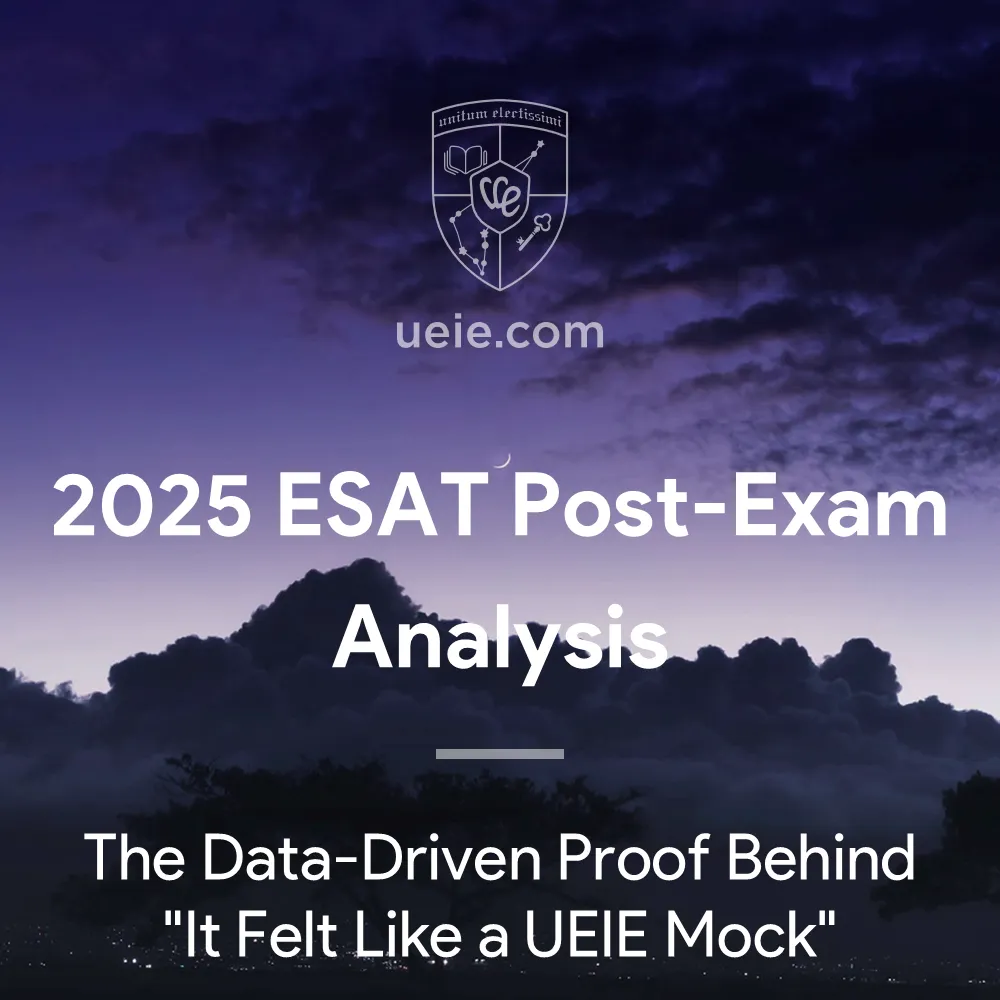
2025 ESAT Post-Exam Analysis: The Data-Driven Proof Behind “It Felt Like a UEIE Mock”
The October 2025 ESAT is all done and dusted. We’ve been hearing all sorts of things from students, but beyond the usual ‘Maths was a nightmare’ and ‘The sciences were a breeze’, pretty much every UEIE student was saying the same thing: ‘Honestly, it felt just like doing one of our mocks!’
And that’s no fluke. It’s what happens when your predictions are spot-on and you’ve got a platform that’s a 99% match for the real deal. So, what I’m going to do now is a proper deep-dive into the 2025 ESAT, using all the feedback we got straight from our students and our own exclusive mock data. I’ll break down exactly what was on the paper, how we saw it coming, and what you should be doing next.
I. The October 2025 ESAT: The Lowdown on What Changed (and What Didn’t)
Compared to the first-ever ESAT, this year’s paper felt a lot more… established. The overall structure was the same, but they’ve clearly had a good tinker with the difficulty levels and are getting much fussier about the exact skills they want to see from candidates. After having a proper chat with dozens of our students, we’ve sussed out a few key changes:
1. Trend One: Maths 1 has become the new ‘separator’.
This year, Maths 1 was miles harder. It wasn’t just about ticking off syllabus points anymore; it was a proper grilling of your abstract thinking, how you build a logical argument, and your raw calculation skills. What’s behind this? Simple: the G5 unis are putting up a massive ‘hard filter’ for applicants. They’re making it crystal clear they only want students who can really think mathematically. This was a massive headache for anyone applying for stuff like Biology or Chemistry, but frankly an advantage for the Physics and Engineering hopefuls with solid maths foundations.
2. Trend Two: The sciences went back to basics. It was about efficiency, not difficulty.
The Physics, Chemistry, and Biology questions looked deceptively simple. But really, they were a sharp test of whether you actually grasped the ‘first principles’. The examiners basically stripped out all the horrible, fiddly calculations to see if you had a gut feeling for the core concepts and could knock up a correct physical or chemical model in no time.
3. Trend Three: ‘Trap questions’ are here to stay. Being meticulous is non-negotiable.
Another huge feature this year was the spike in ‘easy-to-mess-up’ questions. They set little traps all over the place – in the boundary conditions, sneaky unit conversions, or just really subtle wording in the options. This wasn’t just testing what you know, but how obsessively you read the question and how disciplined you are. That’s pretty much the number one rule for any top-level research, to be fair.
4. Trend Four: The hidden ‘race against time’ is a test of execution under pressure.
At its heart, the entire exam was just one long, high-intensity pressure test. It’s not enough to ‘know’ the answer; you have to find it ‘fast’ and get it ‘right’. This double-whammy of testing your processing speed and your nerve is just a normal day at the office when you’re studying or researching STEM at a top level. The ESAT is just making you prove you can handle it before you even get in.
II. From Nailing the Prediction to Proving It in the Exam: How Our Mocks Were a Dead Ringer for the Real Thing
The assessment trends analysed above were a challenge for the average candidate, but for UEIE students, they were familiar scenarios rehearsed repeatedly in mock training.
The feedback we kept hearing again and again—”It literally felt like I was just doing another UEIE mock”—wasn’t a fluke. It just proves our whole philosophy is right: prep isn’t about blindly hammering through a massive question bank. It’s about a high-fidelity simulation of the actual exam, all based on data analysis. Here’s a bit of what our students told us, showing just how closely our training lined up with the real thing.
1. We absolutely nailed the core problem-solving methods
Our main goal with the mocks isn’t to ‘spot’ an exact question. It’s to perfectly replicate the types of models and logical steps the examiners love to use. After the exam, loads of students told us that many of the nasty-looking calculations in Maths 1 and 2 could actually be sidestepped with clever tricks – and the core methods for doing that were identical to what we’d hammered home in our final sprint mocks.
2. We simulated the exam environment and pressure perfectly
Proper prep has to include simulating the environment and the ‘pressure’. We design our mocks to be an exact match for the real thing: same number of questions, same difficulty curve, and a 99% identical exam setup (right down to the interface and timers). The whole point is to train your brain to keep working under pressure and manage your time. And it worked. Students told us that because they were so used to the intensity of our mocks, when they got into the real exam, they just stayed calm and stuck to the plan.
3. We strategically covered the obscure, low-frequency topics
The fight for the top marks always comes down to who’s mastered the obscure, easily-forgotten topics. Our teaching system scans the entire knowledge map and uses data analysis to pinpoint those ‘game-changer’ topics—the ones that rarely come up but are a massive differentiator when they do. This year, a few students got hit with random questions on things like stretching y in an equation, 180° function rotation about an arbitrary point, Young’s Modulus, the density of water between 0-4°C, and vacuum refraction in glass… and every single one was stuff we had strategically covered in our pre-exam intensive training.
III. From ‘Gut Feeling’ to Hard Science: Proving It with Our Mock Exam Data
If student feedback provides qualitative observation, then our back-end mock exam data provides rigorous, visual, quantitative validation.
Here’s why the UEIE prep system is so ridiculously effective: it’s all driven by two main engines. Think of it as a macro-level ‘group evolution’ and a micro-level ‘individual diagnostic. This setup makes sure that every ounce of effort a student puts in goes exactly where it’ll make the biggest difference.
1. The ‘Macro’ View: Watching the Entire Cohort Level Up
Getting a good ESAT score isn’t just about a few star pupils winning; it’s about lifting the entire group. Our ESAT Score Distribution Graph (check it out below) shows this in black and white.
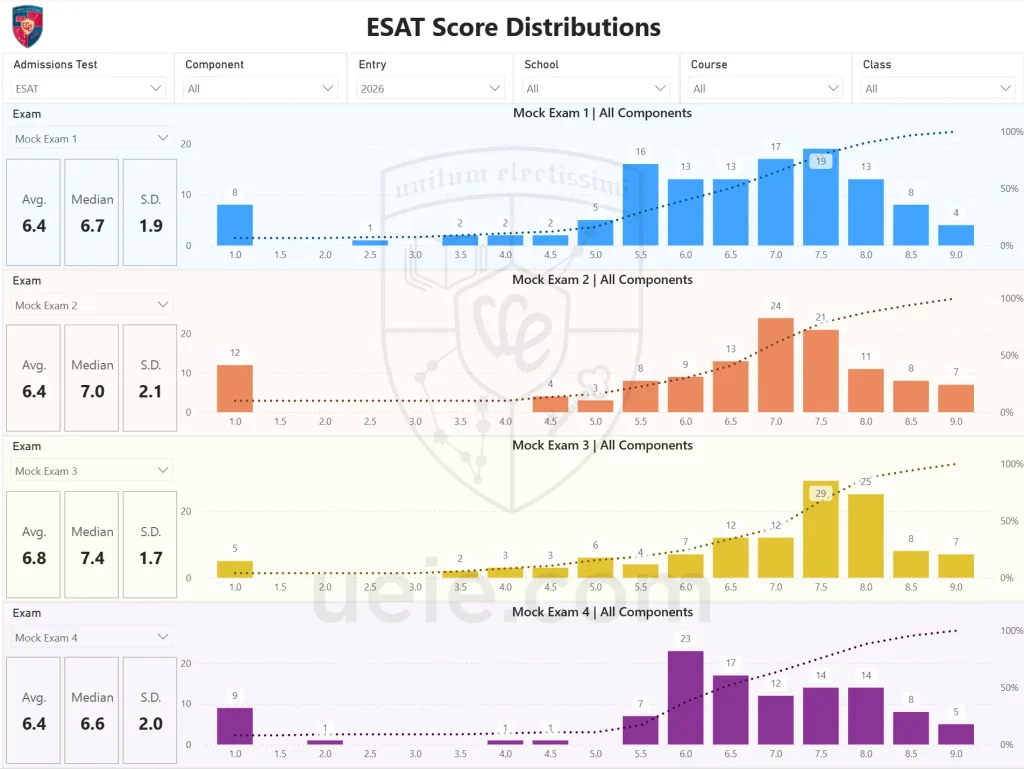
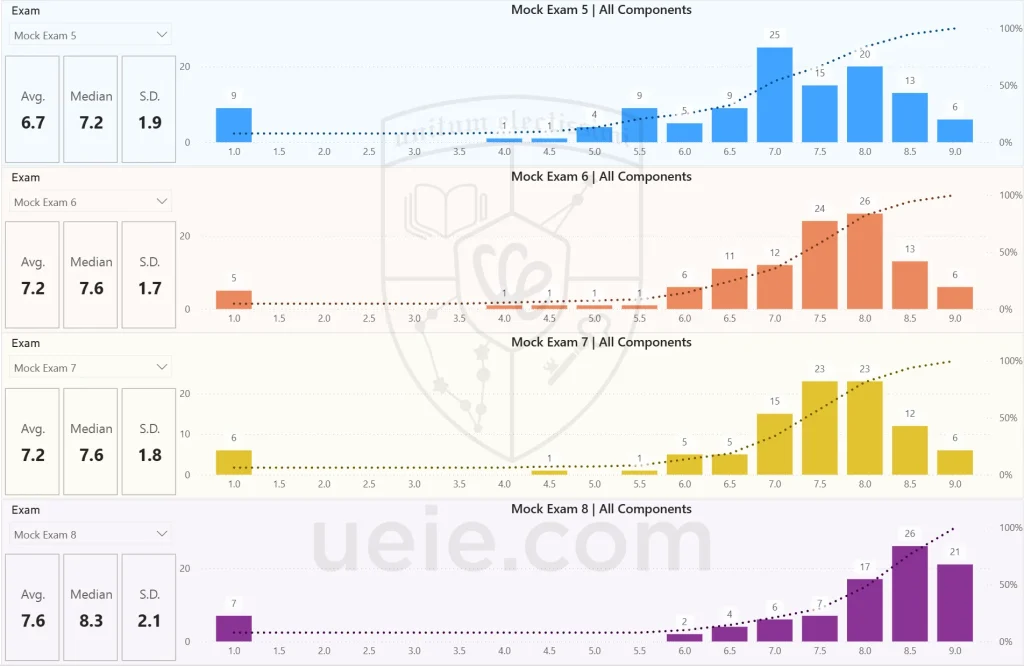
UEIE’s Eight ESAT Mock Exam Score Distribution & Averages
(Mocks 1-8, Sept-Oct 2025)Just look at the journey from Mock 1 to Mock 8. You can clearly see:
- The whole pack kept moving up: The average (median) score for our students started at a decent 6.7 and steadily climbed to a seriously strong 8.3 by the end.
- The top-scorer bracket just exploded: On that last mock—the one we made the toughest to be just like the real thing—pretty much everyone was clustered in that top 8.0-9.0 range.
This is the proof that out training system works. It is systematically pulls up the baseline for everyone and gets the whole cohort sitting comfortably in the G5 admissions zone. We’re not just relying one a few geniuses to make us look good.
2. The ‘Micro’ Diagnostic: Plotting a Unique Growth Path for Every Student
The whole group gets better because each individual gets better. Our Student Personal Report system basically plots a unique journey for every single student. It’s like ‘surgical precision’ for finding and fixing weaknesses.
Here are two classic examples of how it works.
A Textbook Case of ‘Excellence and Stability’
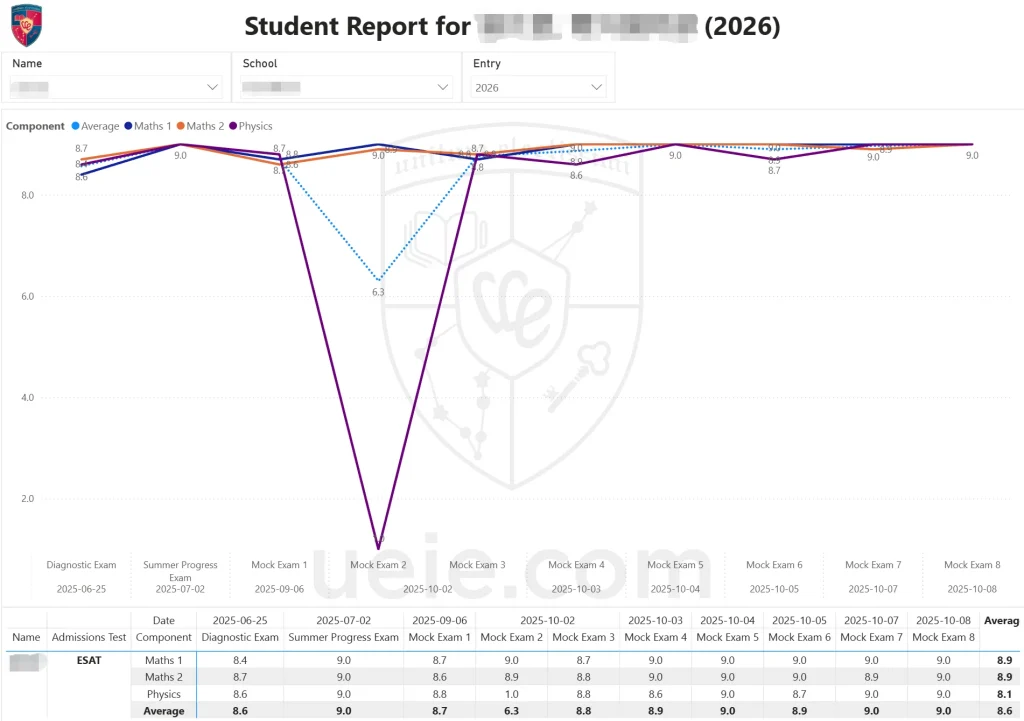
Typical Student (A) – Mock History
(Studying from June – Oct 2025)This student’s score line was basically flat… right near the top. They barely dropped a mark. This just proves their knowledge was already rock-solid. For them, our mocks were the perfect way to stay sharp and plug any tiny, lingering gaps. That kind of consistency under pressure is what raw talent looks like, and it shows the absolute peak our students can hit.
The Perfect Example of ‘Value Added’
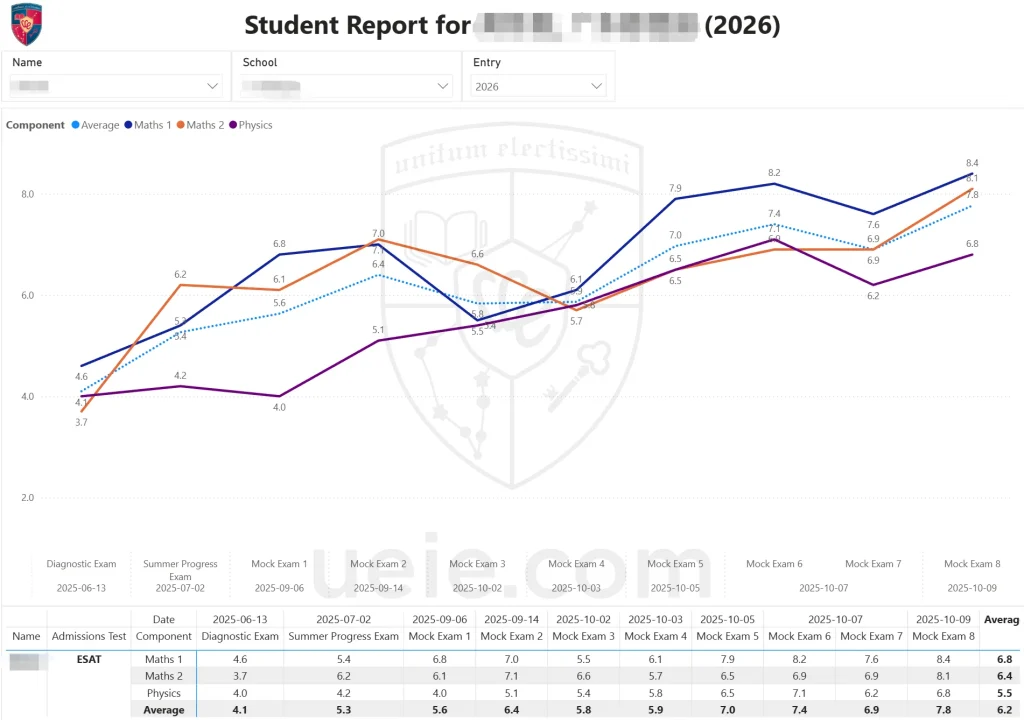
Typical Student (B) – Mock History This student started out at a 4.1 average. By sticking with the eight mocks, getting constant feedback, and doing the targeted training, they finished on a 7.8. That steep upward curve is the best proof you’ll ever see that the hard graft can be measured, and that you can literally watch yourself improve.
IV. The Endgame: From a Top Score to Nailing the Interview
Right, let’s be clear: a brilliant ESAT score isn’t a golden ticket. It just gets you a seat at the table for the final round.
The exam and the interview are testing two completely different skill sets. The exam is all about whether you can find the ‘right answer’ inside a fixed set of rules. The interview—especially for big-hitters like Oxbridge and Imperial—is about finding out if you can build an argument when you’re in totally unknown territory. The interviewers aren’t looking for a perfectly trained ‘problem-solving robot’. They want to find a future colleague—someone who can think straight under pressure, shows massive academic curiosity, and has a rigorously logical mind.
And guess what? We’ve taken the exact same hardcore, systematic approach we used to deconstruct the ESAT exam, and we’ve applied it to deconstructing the interview.
That’s why UEIE is officially launching our interview coaching programme. Our goal is dead simple: to take the massive advantage you built for the written exam and turn it into an unshakeable, winning performance in that interview room.
We’ve built the whole thing around three core modules:
1. 1-to-1, High-Fidelity Mock Interviews
These are led by tutors with serious, senior-level interview experience from Oxbridge and Imperial. We perfectly replicate the pressure and academic depth of the real thing, giving you proper, hands-on combat practice.
2. Logical Framework & Verbal Expression Training
We don’t feed you ‘model answers’. We train you how to build and communicate your thought process, clearly, even when you’re under the cosh. This is the toolkit that will let you handle any curveball question they throw at you with total confidence.
3. Pushing Your Horizons to the Academic Frontier
We’ll get you discussing cutting-edge topics that go way beyond the A-Level syllabus. This is all about helping you build your own unique academic perspective, so you can walk in there and show them you’ve got real passion and huge potential for the subject.
Act Now
To guarantee the highest quality of coaching, our interview preparation places are strictly limited and available only to students who have previously purchased UEIE courses or study materials. Past experience shows that these places are typically booked up in a very short time.
-

ESAT & TMUA Sprint Playbook
In early September 2025, with just one month remaining until key admissions exams like the ESAT and TMUA, we conducted our third stage of benchmark exams. This serves not only as an assessment of past efforts but also as our most valuable strategic roadmap for the final push.
This report provides an in-depth analysis of the exam data, helping you to clearly see your progress, pinpoint areas for improvement, and formulate the most effective preparation strategy for the final thirty days. Remember, every moment of reflection now is an investment in a successful outcome.
I. About the Exams
1. Exam Details
Program Stage 1:
Diagnostic ExamStage 2:
Summer Progress ExamStage 3:
Benchmark ExamExam Type ESAT & TMUA Question Source Original Mock Exams Exam Format Time-limited Online Exam Exam Difficulty ★★★★ ★★★☆ ★★★★ Exam Dates Feb-Jun, 2025 Jul-Aug, 2025 Early Sep, 2025 Exam Scope Open to the public globally*
Internal Exam
Internal Exam
No. of Participants 150+ 50-60 60-70 * The exam was open to participants of all nationalities and ages, with the majority coming from over 30 countries and regions, including mainland China, the UK, India, and Hong Kong.
** The difficulty level was benchmarked against the October 2024 ESAT and TMUA examinations: ★★★
2. Exam Papers and Score Conversion
To ensure fairness and validity, all exams used highly realistic, custom-written questions, with no past paper content. The time limits were identical to the actual exams, and the computer-based exam interface replicates the official platform with over 99% accuracy.
Links to all exam papers and their score conversion tables can be found below. Please note that access to most papers, excluding the diagnostic exam, requires authorisation.
Exam Stage Exam Papers (and Links) Score Conversion Table Conversion Table Version Used Diagnostic Exam TMUA Diagnostic Exam Paper 1
Paper 22025.06.30 ESAT Diagnostic Exam Maths 1
Maths 2
Physics
Chemistry
BiologySummer Progress Exam TMUA Summer Progress Exam Paper 1
Paper 22025.08.30 ESAT Summer Progress Exam Maths 1
Maths 2
Physics
Chemistry
BiologyBenchmark Exam TMUA Mock Exam 1 Paper 1
Paper 22025.09.08 ESAT Mock Exam 1
3. Explanation of the Score Conversion Table
To ensure that a student’s score accurately reflects their relative standing among global candidates, UEIE academic team applies its deep professional experience and a unique algorithmic model to conduct a curve-fitting analysis of the exam data. This process generates a unique score conversion curve for each exam paper, from which the corresponding score conversion table is derived.
Please note that as we continuously acquire new performance data, the conversion curve for each exam is dynamically optimised. Consequently, minor differences may be observed in tables viewed at different times.
Furthermore, although the difficulty level varies between exams, our conversion model has minimised the impact of this variable on the final score to a negligible level.
4. A Brief Guide to the Reported Score
The percentage score is converted into a Reported Score on a scale of 1.0 to 9.0, with 9.0 being the maximum mark.
The number of correct answers needed for a certain score varies by paper and is detailed in each conversion table.
The table below shows the general correlation between Reported Scores and global candidate rankings.
Reported Score Approximate Global Ranking 8.5 Top 3% 8.0 Top 5% 7.5 Top 10% 7.0 Top 15% 6.5 Top 20% 6.0 Top 25% 5.0 Top 50% (The data in the table represents the personal opinion of Xie Tao.)
II. Performance Data and Statistics
To simplify this analysis, the Reported Scores for students across the ESAT and TMUA exams have been combined.
- For TMUA, the average of the two papers is used.
- For ESAT, the average of the three sections is used.
- The average Reported Scores of all students from each exam onstitute the raw data.
1. Performance Trend Over Time
Metric Diagnostic Exam Summer Progress Exam Benchmark Exam Mean Score 5.37 6.37 6.78 Median 5.4 6.4 6.9 Standard Deviation 1.51 0.97 0.89 2. Performance Histograms from Each Exam Stage

Diagnostic Exam Scores
(February – June 2025)
Summer Exam Scores
(July – August 2025)
Benchmark Exam Scores
(Early September 2025)III. Our Progress: Growth Demonstrated by Data
Comparing the data across the three exam stages reveals encouraging signs of progress:
- Significant improvement in overall performance: Both the mean and median scores show a steady upward trend, with the mean score rising from 5.37 to 6.78. This proves the effectiveness of the systematic revision and training from the first two stages.
- The performance gap is narrowing: A steady decrease in the standard deviation (from 1.51 to 0.89) shows that the gap between students is closing. Higher-performing students are consolidating their strengths, while others are working hard to catch up, creating a positive and competitive atmosphere.
IV. Priorities for the Home Straight: Eight Key Areas to Conquer
While this improvement is commendable, we must address the common challenges revealed in this exam. Think of these not as “problems,” but as your clearest opportunities to boost your score.
- Knowledge Retention: Forgetting recently learned topics, particularly in TMUA Paper 2 and the ESAT science sections.
- Conceptual Ambiguity: Imprecise understanding of fundamental concepts and definitions, leading to lost marks on “trick” questions.
- Calculator Dependency: Reduced speed and proficiency in manual calculation due to long-term reliance on calculators.
- Reading Speed Bottlenecks: Slow processing of technical English and long questions, which impacts problem-solving efficiency.
- Sub-optimal Strategies: Using conventional methods to solve problems when faster, more elegant techniques would save valuable time.
- Reduced Practice Time: Summer activities and personal statements have squeezed practice time, leaving students feeling out of touch.
- Stamina and Endurance: A noticeable decline in concentration and energy during longer exams (over 1.5 hours).
- Mindset and Focus Under Pressure: Performance being affected by technical issues, simple errors, or seeing an interim score update.
V. To Our Students: Execute Your Final Push Plan
To address these key areas, execute the following strategies with focus and precision over the final month:
Consolidate Knowledge (For points 1 & 2)
Action: Don’t just review your mistakes—dissect them. Group errors by topic for deeper reflection. Write out key definitions and formulae and place them where you’ll see them every day.
Practise Deliberately (For points 3 & 4)
Action: Take the “Calculator Detox” challenge. From now on, do all calculations with pen and paper. For reading, set a timer and practise reading technical texts or long-form questions every day to improve your speed.
Optimise Your Technique (For points 5 & 6)
Action: Time is your most valuable asset. Commit to a fixed practice schedule. When practising, don’t just aim for the right answer—strive for the “optimal solution.” Master the smart techniques taught in class.
Simulate Exam Conditions (For points 7 & 8)
Action: Physical and mental stamina are critical. Use the 7 upcoming mock exams as your training ground. Adhere strictly to official timings and conditions. Remember: the purpose of a mock is to expose weaknesses. Every setback now is designed to ensure a smooth performance on exam day.
VI. To Our Parents: Providing the Strongest Support
In this final sprint, your support is your child’s greatest asset. We sincerely recommend that you:
- Focus on reassurance, not scores: Mock scores are part of the process. Help your child focus on the “why” behind their results and the “how” of their improvement plan. Your trust is the cornerstone of their confidence.
- Manage the logistics: A consistent routine, nutritious meals, and a quiet study environment are the foundation of effective preparation.
- Provide emotional support: Pay attention to your child’s emotional state. When they feel anxious, listen more and lecture less. A walk or a relaxed chat can be more effective than any motivational speech.
- Work in partnership with us: Trust the school, the teachers, and your child. Maintain communication with us so that, together, we can help them succeed.
VII. Conclusion: Trust the Process, Embrace the Challenge
This final month is for consolidating knowledge, refining skills, and, crucially, mastering your mindset. We hope this analysis helps clarify the path ahead. Please trust that every ounce of effort you have put in has forged the strength you possess today.
-

ESAT vs PAT Comparison: Strategies for Engineering & Science Test Prep
I. ESAT vs PAT: How to Choose Your Key to Top Science and Engineering Universities?
For students and parents preparing applications for engineering or science courses at Oxford, Cambridge, and Imperial College London, the names PAT (Oxford Physics Aptitude Test) and ESAT (Engineering and Science Admissions Test) will likely ring a bell. These are crucial ‘acid tests’ used by these top-tier institutions to select applicants for their science and engineering disciplines.
A common question naturally arises, particularly for those students and parents aiming for engineering or physics programmes at both Oxford and Cambridge/Imperial College: Given that both are science and engineering-related examinations, how significant are the differences between ESAT and PAT? If my child needs to prepare for both, is there an efficient way to combine their preparation? Or are they entirely distinct, requiring separate and independent study?
Admittedly, not all science applicants will need to tackle both examinations. For instance, those applying for courses in chemistry or biology-related fields (ESAT is required for Chemical Engineering and Biotechnology, biological streams of Natural Sciences, and Veterinary Medicine at Cambridge) or materials science (PAT is required for Oxford) typically only need to prepare for one.
This article will delve into the core similarities and differences between the ESAT and PAT examinations. Our aim is to clarify the landscape for all students and parents interested in ESAT and PAT. Specifically for those needing to prepare for both – students applying for engineering or physics – we will focus on analysing the ‘correlation’ and ‘differences’ in their preparation, offering an effective combined strategy. For students who only need to take one examination, this comparison will also provide a deeper understanding of the unique aspects of the exam they face, thereby enabling more targeted preparation.
II. ESAT vs PAT: A Table for Understanding Core Information
First, let’s condense the key information about ESAT and PAT into a table. This will allow you to quickly grasp their overall structure and core differences.
Dimension ESAT Oxford PAT Managing Body UAT-UK University of Oxford Exam Administrator Pearson VUE Pearson VUE Answering Format Online computer-based Online computer-based Paper Structure Total of 5 modules, typically choose 3:
-
- Mathematics 1
- Mathematics 2
- Physics
- Chemistry
- Biology
Unified paper: Mathematics + Physics Question Types and Volume 81 multiple-choice questions (3 modules, 27 questions/module) 40 multiple-choice questions Examination Duration 2 hours in total (3 modules, 40 minutes/module) 2 hours Knowledge Base A Level + GCSE Mathematics / Physics / Chemistry / Biology (depending on selected modules) A Level + GCSE Mathematics + Physics Further Mathematics Not required Not required Scoring Method Standardised score: 1.0-9.0 (after raw score conversion) Raw score: 0-100 Calculator Not permitted Online calculator provided (personal calculators forbidden) Dictionary and Formula Sheet Not permitted Not permitted Required by University/Department - Cambridge: Engineering, Natural Sciences, Chemical Engineering and Biotechnology, Veterinary Medicine
- Imperial College London: Department of Aeronautics, Department of Chemical Engineering, Department of Civil and Environmental Engineering, Dyson School of Design Engineering, Department of Electrical and Electronic Engineering, Department of Mechanical1 Engineering, Department of Physics
- UCL: Electronic and Electrical Engineering
- Oxford: Physics, Physics and Philosophy, Engineering, Materials Science
Summary
As the table above illustrates, both ESAT and PAT are online, multiple-choice examinations administered by Pearson VUE, aimed at applicants for top university science and engineering courses, and neither requires knowledge of Further Mathematics. However, they differ in the breadth of subjects covered (ESAT is broader), whether they are modular (ESAT is), calculator policies, and the final presentation of scores (standardised score vs. raw score).
III. Analysis of Similarities and Differences: Feasibility and Key Points for Combined Preparation
Having grasped the core information, let’s now delve into the feasibility of preparing for ESAT and PAT concurrently, highlighting key areas that demand particular attention.
1. Where does the ‘Feasibility’ of Combined Preparation Lie?
For students aiming to tackle both examinations (specifically those selecting the Mathematics 2 + Physics modules for ESAT), a combined preparation strategy is indeed feasible. This is primarily due to the following commonalities:
Overlapping Mathematical and Physics Knowledge
The content required for ESAT’s Mathematics 1, Mathematics 2, and Physics modules significantly overlaps with the A-Level/GCSE Mathematics and Physics knowledge needed for PAT. This means that when revising core topics such as functions, mechanics, electricity, and basic calculus, you can effectively ‘kill two birds with one stone.’
Shared Skillset
Both examinations place considerable emphasis on a student’s logical-mathematical reasoning, their ability to apply scientific principles to solve practical problems, and their capacity to maintain clear thinking and accuracy under pressure. Honing these core scientific literacies will benefit performance in both tests.
Similar Format
Both are online multiple-choice examinations administered via the Pearson VUE platform. Familiarity with the computer-based testing environment, on-screen reading, and multiple-choice answering techniques is transferable between the two.
2. What are the ‘Points to Note’ for Combined Preparation?
Despite these commonalities, it’s crucial not to treat ESAT and PAT as interchangeable. You must clearly recognise and specifically address the following key distinctions:
ESAT’s Modularity and Breadth
ESAT is structured into five modules: Mathematics, Physics, Chemistry, and Biology. Students must select and prepare for three of these, guided by their university application requirements. This implies a potentially broader knowledge base (particularly if Chemistry or Biology is chosen). Furthermore, during the exam, students will need to swiftly switch between different subject mindsets and manage their time effectively within the independent 40-minute slots allocated to each module.
PAT’s Integration of Physics and Mathematics, and Depth
While PAT only tests Physics and Mathematics, it strongly emphasises their deep integration in problem-solving. Questions may be more comprehensively and ingeniously designed, potentially demanding a more profound understanding of physical concepts and a more versatile application of mathematical tools.
Fundamental Difference in Calculator Policy
This is a critical distinction requiring careful attention:
- ESAT does not permit calculator use. Preparation must therefore involve significant effort in training mental arithmetic, manual calculation, estimation, unit conversion, and the fluent recall of formulae and constants.
- PAT, conversely, provides an online calculator. During preparation, students cannot rely on their familiar personal calculators. Instead, they must invest time in becoming proficient with the specific online tool provided. This includes learning to judge when to use it for complex calculations and when manual calculation or estimation might be more efficient. The training for these two distinct calculation approaches and skillsets is fundamentally different.
Differing Emphasis on Speed
ESAT allocates 40 minutes for 27 questions per module, averaging roughly 1.5 minutes per question. This demands exceptionally rapid knowledge retrieval and reaction speed. PAT, while also multiple-choice and with a total duration of 2 hours for 40 questions (averaging about 3 minutes per question), might appear slightly more relaxed. However, its questions may require more time for thorough reading, comprehension, modelling, and calculation (especially when using the online calculator). Consequently, it places equally high demands on depth of thought and problem-solving efficiency.
IV. Effective Strategy: Devising Your ESAT and PAT Preparation Plan
Having clarified the similarities and differences, we can now formulate an effective preparation strategy, particularly for students requiring combined preparation.
1. From Where Does ‘Effectiveness’ Originate? When is it Applicable?
The ‘effectiveness’ of combined preparation primarily stems from integrating common foundations. It is especially applicable to students whose application pathways cover related courses at Oxford and Cambridge/Imperial College, and who select the Mathematics and Physics modules for ESAT. Consolidating the revision of core mathematical and physical knowledge can effectively save time. However, please remember that the realisation of this efficiency must be predicated on precise, differentiated training.
2. Practical Advice: How to Approach Combined Preparation?
Step One: Confirm Modules and Self-Assess
Firstly, confirm that your chosen course requires or allows the selection of ESAT’s Mathematics 2 and Physics modules! This is the prerequisite for combined preparation. Secondly, objectively assess your proficiency in Mathematics, Physics (and other ESAT elective subjects), and your abilities both with and without calculator assistance.
Step Two: Consolidate Common Foundations
Systematically revise and consolidate the overlapping A Level Mathematics and Physics core knowledge points. Focus on conceptual understanding and mastery of fundamental principles.
Step Three: Differentiated Specialist Training
ESAT Specialist Training
- Undertake rigorous, high-intensity timed multiple-choice practice without a calculator. Focus on training speed, accuracy, and rapid knowledge retrieval skills.
- Practise adapting to module switching to simulate continuous examination conditions.
PAT Specialist Training
- Frequently use the official online practice platform to master the functions and limitations of the online calculator, and to identify the most efficient usage strategies.
- Engage in targeted practice of multiple-choice questions that integrate Physics and Mathematics and demand depth of thought.
- Critically use PAT past papers (note formatting differences prior to 2024), focusing on learning question approaches and the application of physical models.
Step Four: Simulate and Adjust
Periodically undertake full online mock examinations for ESAT (according to module combinations) and PAT, strictly adhering to time and calculator rules.
Based on mock examination results, analyse areas of weakness and promptly adjust revision priorities and training strategies.
Recommended Preparation Time
Considering the breadth of knowledge involved and the training of two different skill sets (particularly regarding calculators), it is advisable to allocate at least 5 months for systematic preparation. It is crucial to start early and ensure consistent, sustained effort.
Official Resources are Fundamental
The official ESAT and PAT websites, syllabuses, sample questions, and online practice platforms are fundamental resources that must be fully utilised.
Platforms such as Isaac Physics are beneficial for enhancing general mathematical and physical abilities.
Considering the unique nature of combined preparation, selecting courses and materials specifically designed for the characteristics of both ESAT and PAT will be significantly more effective. For example, the ESAT + PAT On-Demand Prep Suite and ESAT + PAT Live Classes offered by UEIE.
Key Recommended Resources

ESAT & PAT On-Demand Prep Suite
The ESAT & PAT On-Demand Prep Suite, developed by Xie Tao, is your all-in-one solution for exam success, which includes video lectures covering Maths, Physics, over 1600 practice questions with detailed solutions, and full-length mock exams for ESAT Maths 1, Maths 2, Physics, and the Oxford PAT. Prepare thoroughly and maximise your score.US$612 – US$2 427Price range: US$612 through US$2 427
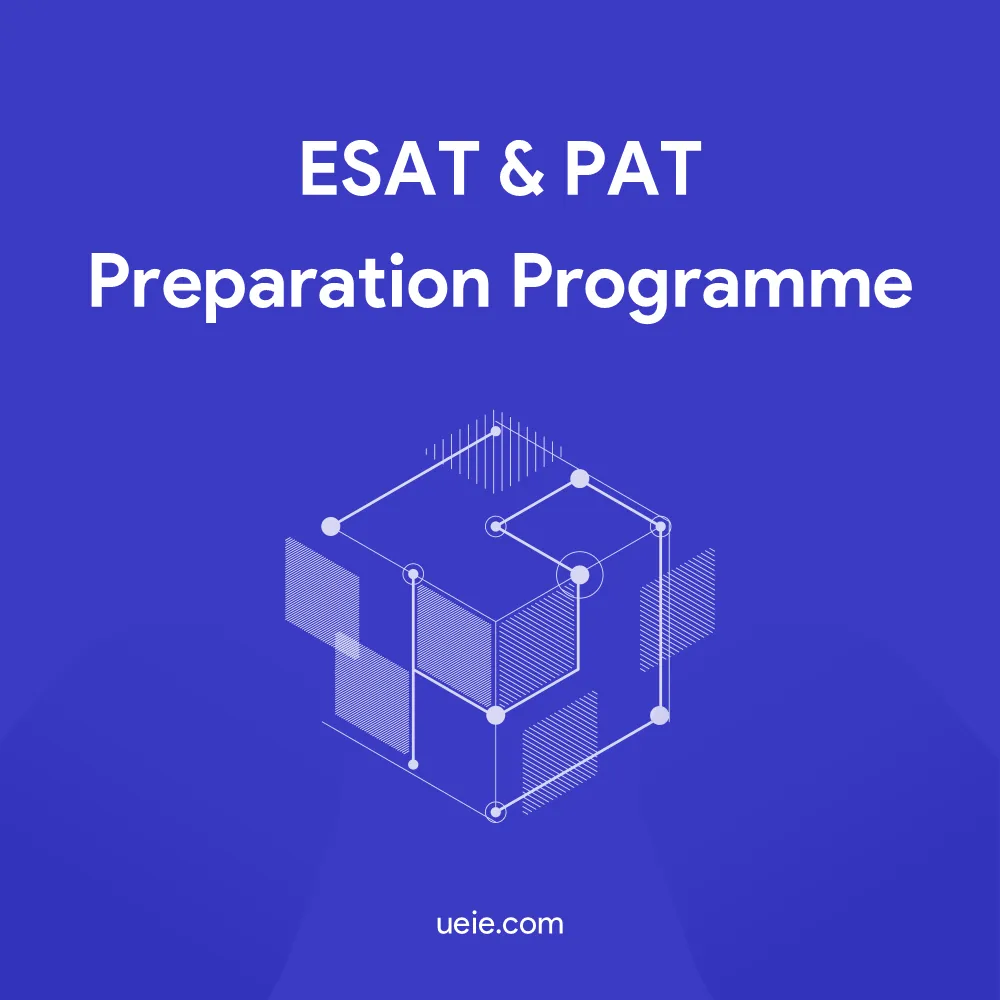
ESAT & PAT Preparation Programme
All-in-one exclusive resources. This programme features a 3000+ question bank, 9 unseen mock exams for each test, and 3 ESAT predictive papers to help you systematically master both new exams. Click to view the bundle.US$3 831 – US$14 265Price range: US$3 831 through US$14 265
The greatest value of such resources lies in their optimised learning paths and training content, already structured according to the similarities and differences between the two examinations. They can clearly guide students on what to learn first, what to practise next, and how to practise most efficiently, thereby avoiding the potential waste of time and energy that can result from students figuring things out themselves. For those pursuing efficient preparation, this is a very wise choice.
3. Key Advice for Parents/Students
Combined preparation for ESAT and PAT is feasible, particularly for students primarily targeting engineering and physics disciplines. However, it is by no means an easy undertaking. The key to success lies in acknowledging and effectively addressing the core differences, especially calculator policies and examination style/structure. Planning must be meticulous, and training must be highly targeted; one cannot simply apply ‘one method for two examinations’.
V. Conclusion: Precise Analysis, Effective Preparation
In summary, ESAT and PAT, as gateways to science and engineering courses at their respective top universities, exhibit significant differences in terms of scope, structure, style, and particularly calculator policy, despite both being online multiple-choice examinations. Through the analysis in this article, we hope to have helped you clarify their core similarities and differences.
For applicants, whether focusing on one examination or needing to tackle both, the key to success lies in precisely understanding the requirements of the target examination, planning scientifically, and undertaking targeted, effective preparation.
Want to learn more? Please see:

ESAT Prep Hub
Master the ESAT with UEIE’s Prep Hub! We offer everything you need to succeed: in-depth video lecture series, extensive practice question bank, realistic full-length mock exams, expert guides, and insightful data analysis.
Oxford PAT Prep Hub
Master the Oxford PAT with UEIE’s Prep Hub! We offer everything you need to succeed: in-depth video lecture series, extensive practice question bank, realistic full-length mock exams, expert guides, and insightful data analysis. -
-

2025 G5 Admissions Tests: Dates, Requirements & Preparation Timeline

I. Admissions Test Reforms: Navigating Your Choices
The landscape of admissions tests for Oxbridge and other G5 universities has been constantly evolving. Recently, several tests have been discontinued, while new ones like ESAT, UCAT, and TARA have emerged. Adding to the complexity, different universities often have varying test requirements even for similar courses, creating significant hurdles for applicants.
Strong performance in these admissions tests is vital for receiving an offer from a G5 university. For students and their parents, keeping up with the latest requirements, selecting the appropriate exams, and preparing efficiently pose considerable challenges.
This guide breaks down the 2025 admissions test schedule and specific course requirements for Oxbridge and G5 universities. Our goal is to assist applicants and their families in defining clear application targets, mapping out a practical preparation timeline, and focusing their efforts strategically to boost their chances of success.
II. Overview of 2025 Oxbridge & G5 Admissions Tests
As soon as universities officially released their 2025 admissions test details, we carefully compiled the following tables. They summarise the name, date, subjects/content covered, and applicable courses for each exam, aiming to provide a clear and quick understanding of this year’s Oxbridge and G5 test arrangements.
Tests for Cambridge, Imperial College, UCL & LSE
Test Name Test Date(s) Subjects/Content Applicable Universities Applicable Courses STEP STEP 2: 11 June 2025 STEP 3: 16 June 2025 2026 dates TBC Mathematics, Further Mathematics Cambridge University Mathematics, Mathematics and Physics ESAT 9 Oct 2025 (Not for mainland China, HK, Macau candidates) 10 Oct 2025 6-7 Jan 2026 (Not for Cambridge candidates) Mathematics 1, Mathematics 2, Physics, Chemistry,Biology Cambridge University Engineering, Chemical Engineering & Biotechnology, Natural Sciences, Veterinary Medicine Imperial College Aeronautics, Chemical Eng, Civil & Environmental Eng, Dyson Design Eng, Elec & Electronic Eng, Mechanical Eng, Physics UCL Electronic & Electrical Engineering TMUA 13 Oct 2025 (Not for mainland China, HK, Macau candidates) 14 Oct 2025 8-9 Jan 2026 (Not for Cambridge candidates) Mathematics Cambridge University Computer Science, Economics Imperial College Computing courses, Maths courses, Economics, Finance & Data Science LSE Economics (Required), Econometrics & Mathematical Economics (Required), Maths & Economics (Recommended) UCL Economics TARA 15-16 Oct 2025 12-13 Jan 2026 Critical Thinking, Problem Solving, Effective Communication UCL Computer Science, Mathematical Computation, Robotics & AI, European Social & Political Studies, Int’l Social & Political Studies, Management Science, Social Sciences, Sociology & Data Science, Sociology UCAT 7 July to 26 Sept 2025 Verbal Reasoning, Decision Making, Quantitative Reasoning Cambridge University Medicine Oxford University Medicine UCL Medicine LNAT 1 Sept to 15 Oct 2025 Reading Comprehension, Essay Writing Cambridge University Law Oxford University Law, Law with European Law LSE Law UCL Law Oxford University’s Specific Admissions Tests
Test Name Test Date(s) Subjects/Content Applicable Courses MAT 22-23 Oct 2025 Mathematics Mathematics, Mathematics & Philosophy, Mathematics & Computer Science, Computer Science, Computer Science & Philosophy PAT 22-23 Oct 2025 Mathematics, Physics Physics, Physics & Philosophy, Engineering, Materials Science TSA 21-24, 27 Oct 2025 Critical Thinking, Problem Solving Section 1 only: Economics & Management, Experimental Psychology, History & Economics, Human Sciences, PPL (Psychology, Philosophy & Linguistics) Sections 1 & 2: PPE (Philosophy, Politics & Economics) AHCAAT 24 Oct 2025 Critical Academic Writing, Analysis of Ancient History Materials Classical Archaeology and Ancient History BMSAT 21-24, 27 Oct 2025 Mathematics, Physics, Chemistry, Biology Biomedical Sciences CAT 22-24 Oct 2025 Latin Translation, Greek Translation, Classical Languages Aptitude Classics, Classics & English, Classics & Modern Languages, Classics & Asian and Middle Eastern Studies MLAT 24 Oct 2025 8 Languages including French, Language Aptitude, Philosophy European & Middle Eastern Languages, Classics & Modern Languages, English & Modern Languages, History & Modern Languages, Modern Languages, Modern Languages & Linguistics, Philosophy & Modern Languages PhilAT 24 Oct 2025 Philosophical Reasoning Philosophy and Theology Tests Cancelled in 2024 and 2025 and Their Replacements:
- Oxford’s HAT (History Aptitude Test) – No replacement
- Cambridge’s ENGAA (Engineering Admissions Assessment) & NSAA (Natural Sciences Admissions Assessment) – Both replaced by ESAT
- BMAT (BioMedical Admissions Test) – Replaced by UCAT or BMSAT (depending on course/university)
Test Format
With the exception of Cambridge’s STEP exams, all the tests mentioned above are delivered online as computer-based exams. They are administered by Pearson VUE at their global test centres.
III. Comparative Analysis of Oxbridge & G5 Test Requirements by Course
This section provides a side-by-side comparison of admissions test requirements for five major subject categories: Mathematics, Computer Science, Engineering, Natural Sciences (Physics), and Economics.
We will focus specifically on:
- Required Tests: Which admissions tests does each university require for the same course?
- Test Difficulty: What is the approximate difficulty level of each test?
- Target Scores (Reference): Apart from Cambridge’s STEP, which has defined grade requirements, other tests do not have official ‘cut-off scores’. The reference scores provided in the tables below are not official data and do not necessarily represent the minimum scores achieved by admitted students.
1. Admissions Test Requirements for Mathematics Courses
University Test Difficulty Target Score (Reference) Cambridge University STEP Hard Grade 1 or above Oxford University MAT Relatively Hard 75+ Imperial College TMUA Medium 6.5+ LSE TMUA Medium 7.0+ Common Test Combinations for Oxbridge & G5 Mathematics Applicants
University Combination Tests Suggested Preparation Time Cambridge + Other G5/Universities STEP+TMUA STEP: 6+ months + TMUA: 2-3 months OR STEP: 3-6 months + TMUA: 3-4 months Oxford + Other G5/Universities MAT+TMUA (STEP optional) 3-5 months (up to 10 months max) Imperial / LSE / UCL + Other Universities TMUA 4-6 months (up to 10 months max) 2. Admissions Test Requirements for Computer Science Courses
University Test Difficulty Target Score (Reference) Cambridge University TMUA Medium 7.5+ Oxford University MAT Relatively Hard 80+ Imperial College TMUA Medium 7.0+ UCL TARA Medium Unknown (New for 2025 entry) Common Test Combinations for Oxbridge & G5 Computer Science Applicants
University Combination Tests Suggested Preparation Time Cambridge + Other G5/Universities TMUA 3-5 months (up to 10 months max) Oxford + Other G5/Universities MAT+TMUA (STEP optional) 3-5 months (up to 10 months max) Imperial + Other Universities TMUA 4-6 months (up to 10 months max) Imperial / UCL + Other Universities TMUA+TARA 4-6 months (up to 10 months max) 3. Admissions Test Requirements for Engineering Courses
University Test Difficulty Target Score (Reference) Cambridge University ESAT Medium Average 7.0+ across 3 modules Oxford University PAT Relatively Hard 75+ Imperial College ESAT Medium Average 6.5+ across 3 modules UCL ESAT Medium Unknown (New for 2025 entry) Common Test Combinations for Oxbridge & G5 Engineering Applicants
University Combination Tests Suggested Preparation Time Cambridge + Imperial / UCL ESAT 3-5 months (up to 10 months max) Oxford + Imperial / UCL ESAT+PAT 3-5 months (up to 10 months max) Imperial / UCL ESAT 4-6 months (up to 10 months max) 4. Admissions Test Requirements for Natural Sciences (Physics) Courses
University Test Difficulty Target Score (Reference) Cambridge University ESAT Medium Average 7.0+ across 3 modules Oxford University PAT Relatively Hard 75+ Imperial College ESAT Medium Average 6.5+ across 3 modules Common Test Combinations for Oxbridge & G5 Natural Sciences (Physics) Applicants
University Combination Tests Suggested Preparation Time Cambridge + Imperial ESAT 3-5 months (up to 10 months max) Oxford + Imperial ESAT+PAT 3-5 months (up to 10 months max) Oxford PAT 3-5 months (up to 10 months max) Imperial ESAT 4-6 months (up to 10 months max) 5. Admissions Test Requirements for Economics Courses
University Test Difficulty Target Score (Reference) Cambridge University TMUA Medium 7.0+ Oxford University TSA Medium PPE & E&M: 85+; Others: 70+ Imperial College TMUA Medium 6.5+ LSE TMUA Medium 7.0+ UCL TMUA Medium 6.5+ Common Test Combinations for Oxbridge & G5 Economics Applicants
University Combination Tests Suggested Preparation Time Cambridge + G5 + Others TMUA 4-6 months (up to 10 months max) Oxford TSA 4-6 months (up to 10 months max) Imperial / LSE / UCL + Others TMUA 4-6 months (up to 10 months max) IV. Admissions Test & Interview Preparation Timeline
This section offers a general timeline for preparing for admissions tests and interviews, designed to help candidates plan effectively. Please note this is just a suggested timeline; your specific schedule should be adjusted based on your individual circumstances and the requirements of your target universities.
Time Period Main Tasks Key Focus Areas Feb – Jun Research, Skills Training 1. Read the latest admissions requirements on the Oxbridge/G5 university websites carefully.
2. Decide on target courses and the required tests.
3. Gather official materials: syllabuses, sample questions, past papers.
4. Understand test formats, question types, difficulty levels.
5. Create a detailed preparation plan or choose suitable prep courses/materials.
6. Strengthen maths and critical thinking skills for tests and interviews.Jun – Sep Systematic Revision, Build Foundation 1. Review foundational knowledge for each test subject based on the syllabus.
2. Use structured courses or materials for topic-specific practice.
3. Complete examples and exercises to consolidate knowledge.
4. Start attempting past papers (if available) to understand question styles and difficulty.October Final Push, Mock Exams 1. Take mock exams to familiarise yourself with timings and procedures.
2. Focus on weak areas identified in mocks.
3. Improve speed and accuracy in answering questions.
4. Get into optimal condition before sitting the actual tests.Oct – Dec Interview Preparation 1. Analyse test results (if released) to assess strengths and weaknesses.
2. Adjust application strategy if necessary (e.g., change target school/course – not applicable if UCAS submitted).
3. Intensify mock interview practice if you receive invitations.Jan – Jun (Following Year) Await Results, STEP Prep (if needed) 1. Wait for admission decisions.
2. If required, prepare for STEP exams (refer to STEP preparation guides). -

October 2024 TMUA & ESAT Scores and Explanations
The TMUA is a crucial benchmark for assessing a student’s mathematical ability. At the same time, the ESAT serves as a gateway to engineering and science-related courses at the University of Cambridge and Imperial College London. Both tests employ a 1.0 to 9.0 grading scale, similar to the IELTS, with higher TMUA and ESAT scores indicating a higher rank and stronger academic abilities in the relevant disciplines.
I. Unveiling the secrets behind the 2024 TMUA and ESAT scores
With this year’s adjusted scoring system, scores now provide a more intuitive reflection of a student’s rank, which is crucial for university admissions. So, where does your score stand? Let’s delve into a detailed analysis of the TMUA and ESAT score distribution.
TMUA

Math 1 ESAT
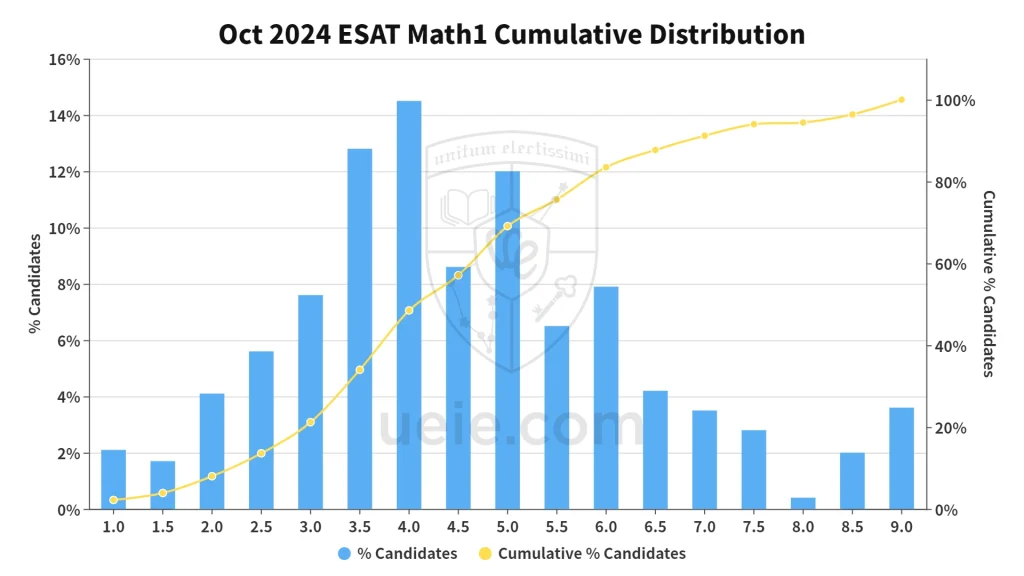
Math 2 ESAT
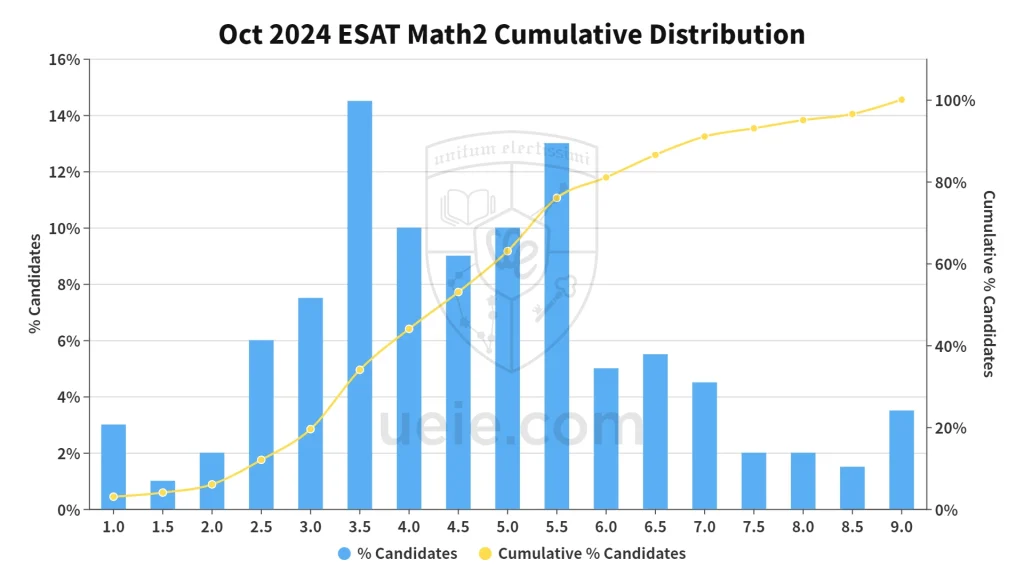
Physics ESAT
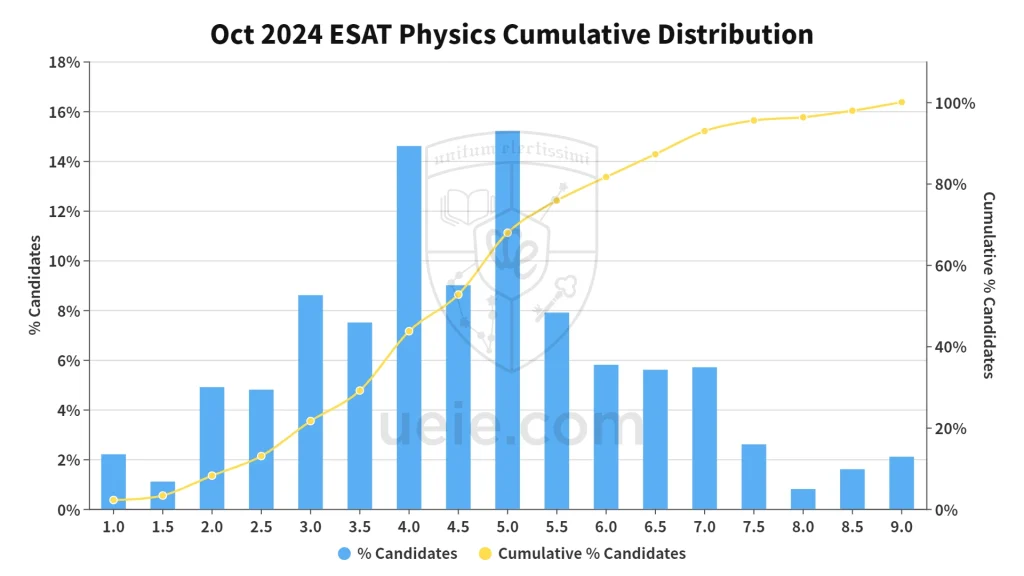
Chemistry ESAT
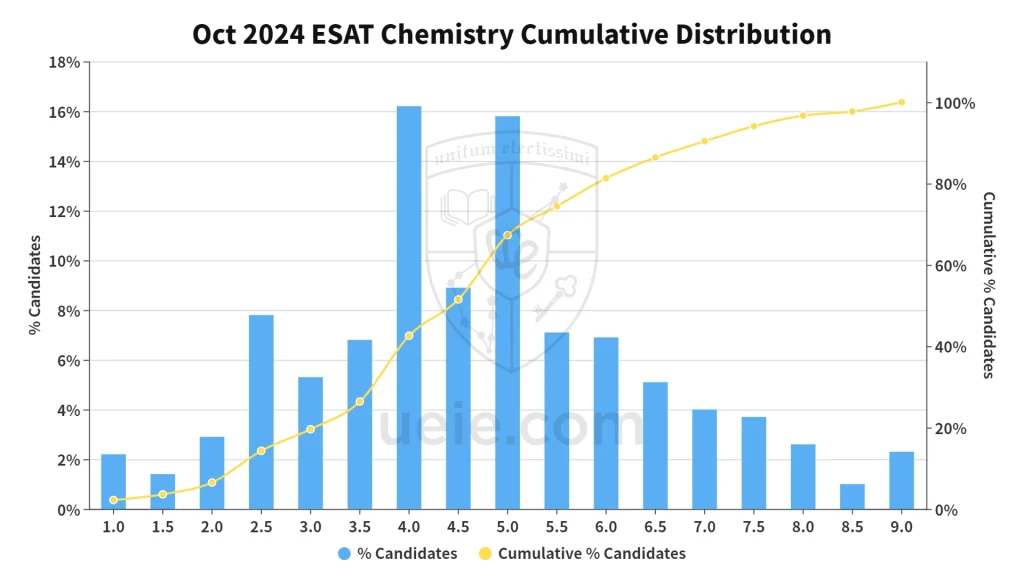
Biology ESAT
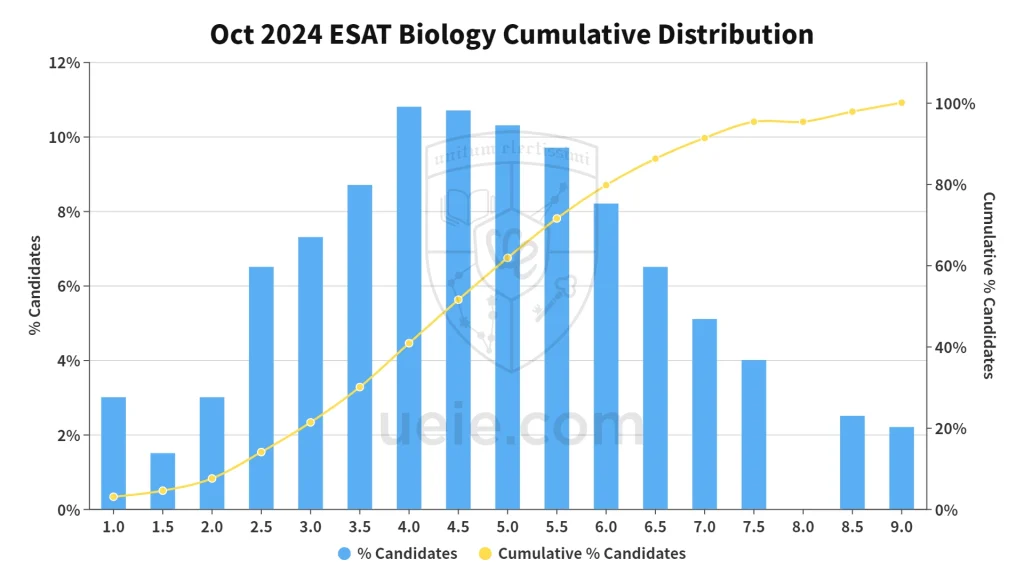
II. Why are there so many applicants who scored 9?
You may have noticed that the percentage of students scoring 9 is higher than those scoring 8 or 8.5! In some tests and subjects, the proportion of 9s even exceeds the combined proportion of 8.0 and 8.5 scores! There are several factors behind this phenomenon:
- A concentration of top students: Each subject attracts a group of exceptionally talented students who possess strong learning abilities and test-taking skills.
- Applicants for mathematics courses also sit the TMUA: Students applying for mathematics courses, who often have a strong aptitude for the subject, tend to score significantly higher on the TMUA compared to those applying for computer science or economics courses.
- Chinese students’ strength in mathematics: It’s well-known that Chinese students excel in mathematics and science. Their advantage in these subjects often gives them an edge in TMUA and ESAT, contributing to the higher proportion of 9 scores.
III. TMUA & ESAT scores: More than just correct answers
The TMUA and ESAT scores are reported on a scale that runs from 1 (low) to 9 (high). Contrary to popular belief, the score is not a simple reflection of the correct answer rate. The exams use multiple test papers, and the difficulty level can vary across different regions and exam times. Under this mechanism, merely counting correct answers cannot accurately assess a candidate’s true ability. Instead, the official scores, derived from rigorous statistical analysis and adjustments, provide a more precise ranking of candidates relative to their peers. Therefore, TMUA and ESAT scores are better understood as a comprehensive assessment of a candidate’s overall ability.
IV. Understanding your TMUA and ESAT score
Regardless of your score, maintain a positive attitude and keep striving for your dreams. Please note that the following interpretations are based on general trends and individual opinions, and should be taken as a reference only:
- 5.0 points: Congratulations! You’ve already outperformed half of the applicants.
- 6.5 points: You have a high chance of receiving an interview invitation from Cambridge. It’s time to start preparing for your interview.
- 7.5 points: Your chances of being admitted to Imperial College London and Cambridge are quite high.
- 8.5 and 9.0 points: If your personal statement and interview (if any) are strong, you can expect offers from top universities like Cambridge, Imperial College London, and LSE.
Of course, there are always exceptions. Factors such as luck, encountering an interviewer who is not a good fit, or performing poorly in an interview can influence the final outcome, even with a high TMUA or ESAT score. Remember, TMUA and ESAT scores are just one piece of the puzzle. Universities consider a variety of factors, including academic performance, personal statements, academic references, and interview performance, when making admissions decisions.
V. Next steps for your application
- Don’t get overly focused on the correlation between your score and the number of correct answers.
- Set realistic academic expectations based on your score.
- Check the official websites of universities for the latest requirements and updates on exam scores.
- Maintain a positive attitude and continue striving for your goals.
We hope the above information helps you better understand your TMUA and ESAT scores and aids in your future academic planning. Explore more preparation resources and posts:

TMUA Prep Hub
Master the TMUA with UEIE’s Prep Hub! We offer everything you need to succeed: in-depth video lecture series, extensive practice question bank, realistic full-length mock exams, expert guides, and insightful data analysis.
ESAT Prep Hub
Master the ESAT with UEIE’s Prep Hub! We offer everything you need to succeed: in-depth video lecture series, extensive practice question bank, realistic full-length mock exams, expert guides, and insightful data analysis. -

Conquer the ESAT: Multi-Subject Strategies for Online Test Success

Acknowledgements
Profound gratitude is extended to Joy, our esteemed chemistry specialist, and Sara, our distinguished biology specialist, for their invaluable contributions to the chemistry and biology sections of this ESAT preparation guide.
In preparing for the Engineering and Science Admissions Test (ESAT) – a relatively recent online assessment demanding exceptional speed and precision in the application of knowledge – many students may find themselves at a crossroads: How can one most effectively cultivate the integrated application of knowledge across diverse courses? What is the optimal approach to structuring one’s preparation for maximum efficacy? Furthermore, how does one best adapt to the intricacies of an online, computer-based test format?
This ESAT Preparation Guide distils my (Mr. Xie Tao’s) accumulated years of practical experience and considered insights from mentoring students through comparable written assessments and allied academic competitions. This provides a systematic, effective preparation framework. It offers strategies and methodologies. These empower you to tackle ESAT challenges successfully.
Prior to immersing yourself in the preparatory strategies detailed within this guide, it is unequivocally recommended that you first undertake a thorough review of the ESAT Comprehensive Guide. This will ensure a complete understanding of the most current developments, specific requirements, test format, and detailed scoring criteria.
I. Defining Objectives and Undertaking Self-Appraisal
Start your ESAT preparation with clear purpose. First, define your target outcome precisely. Then, assess your current capabilities accurately. This foundation is crucial. This basic understanding is the base for building all good study plans.
1. Establishing Clear Target Requirements
Before spending lots of time preparing, you need to know these key details:
- Confirmation of Examination Necessity and Subject Configuration: Is the ESAT a mandatory component for admission to your chosen university and course? If so, which specific combination of subject modules is stipulated? It is crucial to consult the official admissions portal of your target institution to procure the most up-to-date and definitive information, as this will directly delineate the scope of your preparatory endeavours. (Reference may be made to the information presented in Part III of the ESAT Comprehensive Guide).
- Comprehending the Significance of Scores: ESAT scores serve as a significant data point for universities in their holistic evaluation of applicants, playing a particularly vital role in distinguishing candidates with pronounced academic aptitude. While admissions teams set no fixed passing score, a high mark will significantly boost your application’s competitiveness. (For an in-depth interpretation of scoring, please refer to Part VI of the ESAT Comprehensive Guide).
2. Conducting an Initial Self-Appraisal
The ESAT is a new online exam. It uses multiple-choice questions without calculators. Taking a first practice test is very important. This will enable you to:
- Acclimatise to the Authentic Examination Milieu: Gain first-hand experience of the online testing platform’s user interface, the manner in which questions are presented, the considerable temporal constraints of completing 27 multiple-choice questions within a 40-minute timeframe for each module, and the computational demands inherent in a non-calculator setting.
- Evaluate Your Current Proficiency Across Subjects: Formulate an initial assessment of your command of the subject matter, problem-solving velocity, and accuracy in the compulsory Mathematics 1 module, alongside your two intended elective modules. This will allow you to identify the principal discrepancies between your current skill set and the requirements of the examination.
3. Method for Conducting a Diagnostic Assessment
Selection of an Assessment Instrument
Prioritise official UAT-UK online practice exams. Also try their sample questions. These give the most real-like practice tests. They match real exam conditions well.
Reputable third-party online mock assessments may also be utilised, such as the free ESAT online diagnostic exam offered by UEIE. This test aligns with the latest ESAT syllabus. It matches current difficulty levels too. It evaluates core knowledge and skills astutely. These are essential for the ESAT exam. Find test details and access below.
UEIE Free ESAT Diagnostic Exam
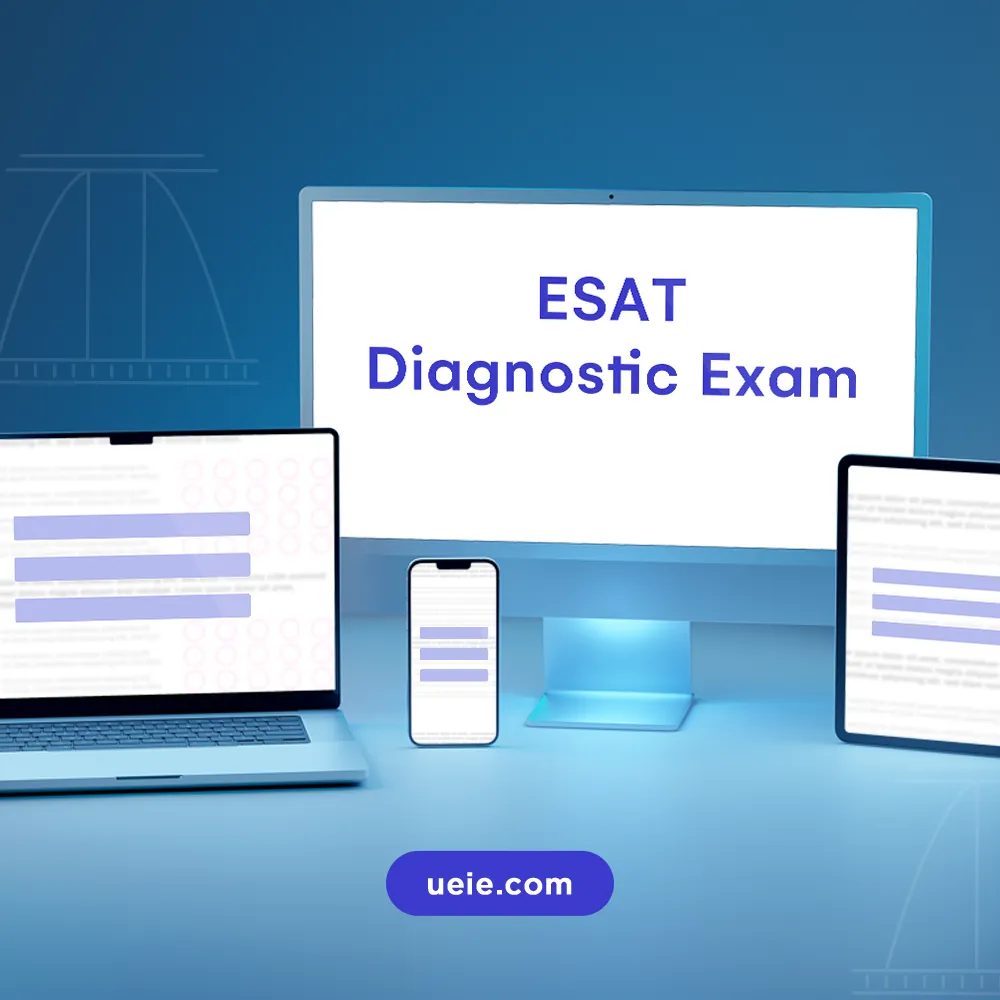
Free ESAT Diagnostic Exam
Assess your skills across Maths, Physics, Chemistry & Biology. Identify strengths and weaknesses across all ESAT subjects. This free ESAT diagnostic provides detailed analysis. Get expert feedback from UEIE’s tutors and improve your university applications.- Alternatively, past ENGAA/NSAA papers can serve as a testing resource. But note: these papers confirm knowledge mastery only. They can’t replicate ESAT’s online format fully. The interface simulation is incomplete. Also, carefully check syllabus congruity always.
Replication of Authentic Conditions
- Adhere rigorously to an independent 40-minute time allocation for each module. Also, complete your three chosen modules consecutively. This helps gauge the exam’s overall intensity accurately.
- Take the exam on a computer. Never use calculators. Use only pen and paper for rough work.
- Ensure an environment conducive to concentration, free from noise and other potential distractions.
Objective Scrutiny and Analysis
- Compare your responses against the provided answer key or system-generated score to objectively appraise your performance in each module.
- Concentrate your analysis on the Causal factors of any errors (undertaking this on a subject-by-subject basis): Were they attributable to overlooked areas of knowledge? An imprecise understanding of core concepts? Arithmetical inaccuracies? Misinterpretations of textual information? Ineffective time management? Or perhaps a deficiency in multiple-choice question techniques?
- Systematically record your identified areas of weakness in each subject; these will serve as focal points for your subsequent preparatory efforts.
4. Formulating Scientific ESAT Score Objectives
Having acquired an understanding of the requisite standards and your own initial standing, the subsequent stage involves the formulation of scientific and pragmatic preparation objectives.
- Interpreting Scores and Attainment Levels
- The 9-point scaled scores awarded for each ESAT module necessitate interpretation within the context of university entry requirements and the broader competitive landscape. Consult the analysis pertaining to the competitive standing of various score bands (e.g., 4.5, 7.0, 8.0+) in Part VI of the ESAT Comprehensive Guide to ascertain the relative positioning of your target attainment level.
- Establishing SMART Objectives
- Specific: For each module you are required to sit, define a desired score range (e.g., Mathematics 1 target: 7.5+; Physics target: 7.0+).
- Measurable: Your objectives should be quantifiable and trackable through scores achieved in subsequent mock assessments.
- Achievable: Formulate attainable objectives predicated on your baseline evaluation, available study time, and anticipated level of commitment.
- Relevant: Your objectives should be directly aligned with the overarching aim of enhancing your overall application competitiveness.
- Time-bound: Clearly delineate the timeframe within which you aim to achieve your stated objectives.
- Striking a Balance Between Ambition and Pragmatism
- Your objectives ought to be sufficiently challenging to harness your full potential, yet concurrently realistic to obviate undue anxiety. Your primary focus should be on demonstrating the zenith of your proficiency in the respective subjects during the examination.
5. Cultivating the Appropriate Mindset to Confront the ESAT Preparation Challenge
ESAT preparation constitutes a rigorous examination of one’s knowledge, alacrity, technical skill, and mental fortitude. It is imperative that you:
- Embrace the Challenge: Perceive this as an invaluable opportunity to augment your scientific literacy, mathematical prowess, and examination-taking acumen.
- Acknowledge Your Current Position: Baseline assessment scores are intended solely for diagnostic purposes and are not indicative of your ultimate potential. Maintain the conviction that significant improvement is attainable through dedicated effort.
- Concentrate on the Process: Direct your focus towards achieving an in-depth comprehension of the subject matter, enhancing your problem-solving capabilities, and refining your strategic approach.
- Preserve Resilience: Difficulties may well be encountered during the preparatory phase. It is vital to maintain a positive disposition, learn constructively from errors, and exhibit unwavering perseverance.
II. Essential Foundational Knowledge for ESAT Preparation
A precise understanding of the specific knowledge prerequisites for each ESAT subject, effectively integrated with your individual educational history, represents the inaugural step towards an efficient and productive preparation regimen.
1. Syllabus Parameters and Fundamental Prerequisites
- Standard of Knowledge: The ESAT primarily evaluates core competencies in Mathematics, Physics, Chemistry, and Biology, benchmarked against the UK A-Level standard (or its recognised equivalent). Exam boards also assume candidates have a strong foundation in GCSE-level subjects (or accepted equivalents).
- Mathematics 1 Module: The topics encompassed within this module are comparatively foundational, addressing number theory, algebra, geometry, elementary statistics, and probability. Standard secondary math curricula cover these areas well. Examples include GCSE Higher Tier or UK Key Stage 4 content.
- Exclusion of Advanced Material: The ESAT does not incorporate content from A-Level Further Mathematics, nor does it generally venture into knowledge domains extending beyond the A-Level syllabus in any given subject.
2. Knowledge Alignment and Counsel for Diverse Curriculum Systems
Irrespective of the curriculum system you are currently following, the critical imperative is to proactively and meticulously juxtapose your existing learning content with the official ESAT syllabus. This process will enable the identification of potential knowledge lacunae or areas of relative weakness, thereby facilitating the formulation of a targeted supplementary study plan.
The ensuing table delineates the approximate correspondence between the principal ESAT elective modules and prevalent curriculum systems, accompanied by pertinent recommendations:
ESAT Module
A-Level
AP
IB
UK National Curriculum (England)
Mathematics 2
Strictly circumscribed by the A-Level Mathematics syllabus.
Calculus AB/BC addresses calculus; supplementary revision of non-calculus elements from Pre-Calculus, such as algebra, functions, trigonometry, and coordinate geometry, is requisite.
DP Mathematics SL (Analysis and Approaches / Applications and Interpretation) generally encompasses the requisite topics; HL knowledge is not deemed essential.
A-Level Mathematics (current specification) addresses the majority of the knowledge base; study of fundamental calculus is necessary if not previously undertaken.
Physics
Typically necessitates prospective study of certain A2 components (e.g., thermal physics, wave phenomena, modern physics). Specific topics previously encountered at GCSE/IGCSE level will be assessed according to A2 standards.
Physics C (Mechanics + Electricity & Magnetism) or a synthesis of Physics 1 and 2 affords extensive coverage, yet meticulous cross-referencing with the syllabus is imperative; supplementation may be required (e.g., waves, thermal physics, modern physics, elementary astronomy).
DP Physics HL Core provides substantial coverage; proactive study of pertinent HL physics topics stipulated by the syllabus is advisable (Optional topics are not required); particular attention should be devoted to enhancing calculus-based physics calculation proficiency.
Physics (as part of, for instance, a 3 A-Level combination) covers a significant portion of mechanics and electricity. Areas such as waves, thermal physics, modern physics, and calculus-based computations may represent relative weaknesses and demand targeted reinforcement.
Chemistry
Subsequent to AS completion, further A2 content requires supplementation, notably in domains such as the structure of matter, chemical principles (kinetics, equilibrium, energetics), and core organic chemistry.
AP Chemistry generally furnishes sound coverage of ESAT topics; nonetheless, a granular, item-by-item verification against the syllabus details is strongly recommended.
DP Chemistry SL addresses a broad spectrum of topics, but relevant HL topics concerning structure, principles, organic chemistry, etc., necessitate supplementation in alignment with the syllabus. Diligence regarding the pace of study is crucial.
A-Level Chemistry (current specification) covers most topics, but certain aspects of organic chemistry and experimental analysis may warrant supplementation. Reinforcement of relevant English scientific terminology is also important.
Biology
AS-level knowledge accounts for most content, but due attention must be paid to the breadth and depth stipulated by the syllabus. Particular emphasis should be placed on fortifying experimental analysis skills and the application of mathematical principles within a biological context.
AP Biology provides comprehensive coverage, but dedicated focus should be directed towards the cultivation of experimental analysis skills and mathematical application capabilities, as the emphasis herein may subtly diverge from that of the ESAT.
DP Biology HL offers extensive coverage; a strengthening of physiological knowledge is required, alongside an enhancement of experimental analysis capabilities and mathematical reasoning in the context of biological problem-solving. Prudent management of the study pace is essential.
Upon completion of A-Level Biology (current specification), the primary requirement is to bolster scientific inquiry (experimental analysis) skills and to adapt to reading comprehension and specialist vocabulary within an English-language academic milieu.
Core Recommendation
It must be emphasised that curriculum systems serve merely as a contextual framework; they should not be regarded as directly equivalent to ESAT requirements. It is indispensable to have the official ESAT syllabus readily available, to undertake a comprehensive, point-by-point comparison, and to subsequently compile a bespoke inventory of knowledge areas requiring supplementation.
3. The Significance of a Background in Subject-Specific Competitions
Value of Transferable Competencies
- While participation in pertinent subject-specific competitions (Physics, Chemistry, Biology, Mathematics) may offer somewhat limited direct assistance in terms of ESAT knowledge points, it is exceptionally advantageous with regard to the development of problem-solving skills and cognitive approaches. Training for such competitions typically cultivates:
- Enhanced rigour in logical deduction.
- Greater adaptability and finesse in problem-solving methodologies.
- Improved capacity and alacrity in addressing complex challenges.
- Increased resilience when operating under pressure.
These competencies are exceedingly valuable when confronting the high-intensity, rapid-fire multiple-choice questions characteristic of the ESAT.
Guidance on ESAT Preparation
- For individuals with a competitive background: Capitalise upon your established skill advantages, but it remains imperative to revert to the ESAT syllabus for systematic revision, and to undertake specific training to enhance speed and refine multiple-choice strategies.
- For individuals lacking a competitive background: The primary emphasis should be on consolidating the foundational knowledge stipulated by the syllabus, and on augmenting application skills, computational speed, and multiple-choice techniques through extensive, targeted practice. There is no requirement to deliberately assimilate knowledge points exclusive to competitive events.
III. Indispensable Core Abilities for Attaining High ESAT Scores
A thorough command of the knowledge prescribed by the ESAT syllabus is undeniably fundamental; however, this alone is insufficient to guarantee distinguished scores in an examination of such intensity. To consistently and accurately resolve an online multiple-choice question within an average timeframe of approximately 1.5 minutes, and to sustain this level of performance for a duration of two hours, it is essential that you meticulously hone the following highly pertinent core abilities.
1. Robust Subject Comprehension and Application Prowess
Profound Grasp of Core Concepts:
It is inadequate to merely commit formulae and definitions to memory at a superficial level. A profound comprehension of the underlying physical, chemical, or biological principles, or the mathematical logic pertinent to each knowledge point, including its specific parameters of applicability, is indispensable. This forms the basis for rapidly discerning the thematic focus of a question and effectively eliminating distractor options.
Adroit Application of Knowledge:
The capacity to interconnect seemingly disparate knowledge points, to apply them with versatility to novel and unfamiliar scenarios presented within questions, and to swiftly construct accurate problem-solving frameworks or conceptual approaches.
2. High-Velocity, Precision Calculation Skills (in a Non-Calculator Setting)
Cardinal Requirement
The use of calculators is strictly prohibited throughout the entirety of the ESAT, and temporal constraints are exceptionally stringent. This imposes exceptionally demanding dual requirements upon calculation skills: both rapidity and precision.
Focal Points of Ability
Proficiency in mental arithmetic and written calculation methodologies is crucial, particularly concerning commonly encountered formulae, algebraic transpositions, the resolution of equations, unit conversions, the correct application of significant figures, and estimations of orders of magnitude.
- Computations involving elementary calculus and trigonometric functions, as encountered in the Mathematics modules (notably Mathematics 2) and the Physics module, must be executed with both speed and unerring accuracy.
- Calculations within the Chemistry module, such as those pertaining to stoichiometry, concentration, and reaction kinetics, must likewise be dispatched with efficiency.
Prevalent Deficiencies
Particularly for students educated within international curricula who may have developed a reliance on calculators, computational speed and precision often represent significant impediments. Extensive, specialised, timed practice sessions, conducted entirely without the aid of a calculator, are therefore essential.
3. Efficacious Online Multiple-Choice Strategies and Techniques
Central Tenet of Strategy
The overarching objective is the maximisation of attainable scores within the prescribed time limits. This necessitates not only a comprehensive knowledge base but also a sophisticated strategic approach.
Pivotal Techniques
- Expeditious Question Scrutiny to Isolate Key Information: The ability to rapidly assimilate the question stem (which may incorporate diagrams or extensive textual passages) and extract the core informational elements and the fundamental nature of the problem.
- Option Analysis and Systematic Elimination: Proficient utilisation of diverse methodologies such as logical deduction, dimensional consistency checks, the substitution of specific or limiting values, the analysis of extreme case scenarios, and reasoned estimation, so as to swiftly reduce the field of potential answers and identify ‘decoy’ or misleading options.
- Time Management and Judicious Decision-Making: The capacity to quickly appraise the approximate difficulty level and anticipated time requirement for each question, to decisively defer more challenging questions (while making appropriate annotations), thereby safeguarding the scoring rate for foundational and intermediate-level items. Cultivate the art of strategic guessing when appropriate.
4. Accomplished Adaptation to the Online Platform
Environmental Familiarisation: It is imperative to achieve a high degree of familiarity with the Pearson VUE examination interface – including its functional buttons (such as flagging, navigation), the mode of question presentation, and methods for option selection – through sustained engagement with official practice platforms or high-fidelity simulation systems.
On-Screen Reading Efficacy: Develop your capacity for sustained concentration and efficiency when reading mathematical and scientific questions and their corresponding options presented on a screen for extended periods.
Synergy Between Online and Offline Resources: The ability to efficiently coordinate the use of the on-screen display, any available online tools (should these be introduced in future iterations), and the erasable booklet furnished at the test centre for the purposes of cogitation and calculation.
5. Formidable Resilience and Concentrative Power
Addressing Sources of Psychological Pressure These may include extreme temporal pressure, accumulated fatigue arising from the consecutive undertaking of multiple modules, the intellectual demands posed by complex questions, the computational duress engendered by the non-calculator constraint, and the operational demands of the online environment itself.
Requisite Capabilities The ability to maintain composure and clarity of thought when subjected to high-pressure conditions, to sustain focused attention, thereby mitigating errors attributable to anxiety (such as misinterpreting questions, committing arithmetical errors, or inadvertently selecting incorrect options), and to perform with consistency even during the final, time-critical phases of the examination.
IV. Strategic Considerations for ESAT Subject Module Selection
The judicious selection of an appropriate ESAT subject module combination constitutes an elementary yet pivotal step in the overarching architecture of your preparation plan. This decision directly influences the ambit of your preparatory endeavours and the commensurate allocation of your intellectual energies. An injudicious choice at this stage carries the potential to invalidate your application. This section, therefore, proffers strategic counsel and considered recommendations pertinent to subject selection, predicated upon commonly pursued academic pathways.
1. Comprehending Selection Protocols and Fundamental Maxims
Adherence to Prescribed Regulations and Primacy of Official Mandates: As a general rule, Mathematics 1 is a compulsory module. Candidates are then typically required to select two additional modules in accordance with the specific academic requirements of their intended course of study, culminating in a total of three modules. In instances where a university explicitly stipulates a set of obligatory modules, adherence to such directives is absolute, leaving no latitude for discretionary choice. (For a detailed exposition of these regulations, please consult Part Three of the Comprehensive ESAT Guide).
The Subjectivity of Perceived ‘Difficulty’: It is inadvisable to become excessively preoccupied with discerning which subject might be intrinsically ‘easier.’ The relative difficulty of the examinations is meticulously calibrated through a process of score adjustment (Scaled Score), ensuring that the final score accurately reflects a candidate’s performance relative to the broader cohort undertaking that specific subject. Consequently, a more efficacious strategy generally involves selecting subjects wherein you exhibit greater inherent aptitude, possess a more profound intrinsic interest, or which demonstrate a more immediate and substantive relevance to your prospective field of university study.
Evaluation of Preparatory Resource Availability: Due consideration must also be accorded to the sufficiency of available preparatory resources for the respective subjects. This encompasses the extent of your extant curricular coverage, the accessibility of pertinent academic support and tuition, and the availability of suitable practice materials.
2. Counsel on Subject Selection for Diverse Academic Disciplines
The ensuing recommendations are primarily directed towards scenarios wherein a degree of elective flexibility exists (i.e., subsequent to the compulsory Mathematics 1 module, a choice of two modules is to be made from the remaining four).
Engineering Disciplines
- University of Cambridge Engineering: No elective scope is afforded; candidates are unequivocally required to select Mathematics 1 + Mathematics 2 + Physics.
- Imperial College London, University College London (UCL):
- Physics-Centric Engineering (e.g., Aeronautical, Civil, Electrical, Mechanical Engineering): The combination of Mathematics 1 + Mathematics 2 + Physics is customarily recommended or mandated. Mathematics 2 and Physics constitute core foundational knowledge for these engineering specialisms.
- Chemical Engineering: The typical requirement is Mathematics 1 + Mathematics 2 + Chemistry.
- Design Engineering (Imperial College London): Requires Mathematics 1 + Mathematics 2; a third science module is not stipulated.
- Principal Recommendation: For the majority of engineering pathways, the combination of Mathematics 2 + Physics represents the most prevalent and generally advisable selection.
Physical Sciences Disciplines
- Physics: The selection of Mathematics 1 + Mathematics 2 + Physics is almost invariably a prerequisite.
- Chemistry/Materials Science: Customarily requires Mathematics 1 + Chemistry. The third module is generally recommended to be chosen from either Mathematics 2 or Physics.
- Principal Recommendation: Candidates possessing a robust mathematical foundation who wish to showcase pronounced mathematical and physical reasoning abilities should opt for Mathematics 2. Conversely, those with a more securely established grounding in physics, or who are applying for degree programmes with a distinct leaning towards physical chemistry or materials physics, may find Physics to be the more advantageous choice.
University of Cambridge Natural Sciences
- Subject selection within this stream affords a notable degree of flexibility. Notwithstanding the compulsory Mathematics 1 module, candidates are advised to select two further modules from Mathematics 2, Physics, Chemistry, and Biology, aligning their choices with their intended areas of specialisation during the initial year of university study. By way of illustration:
- Prospective Physics Specialisation: The recommended combination is Physics + Mathematics 2.
- Prospective Chemistry Specialisation: The recommended combination is Chemistry + Mathematics 2/Physics.
- Prospective Biochemistry/Molecular Biology Specialisation: The recommended combination is Chemistry + Biology.
- Prospective Physiology/Neuroscience Specialisation: The recommended combination is Biology + Chemistry/Mathematics 2.
Biological/Medical Sciences Disciplines
- University of Cambridge Veterinary Medicine: Mathematics 1 is a compulsory component. The remaining two modules are typically recommended to be selected from Chemistry and Biology. Physics or Mathematics 2 are not generally considered optimal choices for this pathway.
- Other Biology-Related Degree Programmes (should future university mandates so require): Mathematics 1 is usually a compulsory module. A strong recommendation is made for the inclusion of Biology. The third module should then be selected from either Chemistry or Mathematics 2.
- For degree pathways with a significant emphasis on experimental methodologies, physiology, or ecological studies, Chemistry may represent a more congruous selection.
- For pathways with a pronounced focus on biocomputation, biostatistics, or theoretical biology, Mathematics 2 may confer a more distinct advantage.
- It is important to note the considerable computational demands and the requisite level of mathematical proficiency associated with both the Chemistry and Mathematics 2 modules.
3. Paramount Considerations in Subject Selection Deliberations
- Personal Academic Strengths: In which subjects do you consistently demonstrate superior performance and possess the greatest degree of academic self-assurance?
- Exigencies of Future Academic Pursuit: Which subjects constitute the indispensable intellectual bedrock for your intended course of university study?
- Efficiency of Preparation: When considered in conjunction with your existing curricular background, which combination of subjects lends itself to the most efficient and productive preparatory regimen?
- Intrinsic Academic Interest: Towards which subjects do you harbour the most genuine intellectual curiosity and enthusiasm? Such interest often serves as the most potent catalyst for sustained effort.
Concluding Counsel
Undertake a meticulous examination of all pertinent university admission requirements. Thereafter, synthesise this information with a candid appraisal of your individual circumstances – encompassing your academic strengths, intellectual interests, and foundational knowledge – to arrive at the most judicious and personally advantageous selection. Should any ambiguities persist, it is advisable to seek the counsel of your institution’s university guidance professionals or other suitably experienced academic advisors.
V. Core ESAT Preparation Strategies and Resource Optimisation
Having established a firm grasp of the requisite knowledge base and a clear delineation of the essential abilities, the subsequent consideration is how to translate these foundational elements into a coherent and actionable preparatory regimen. This section aims to furnish you with a structured, phased, and resource-integrated preparation strategy for your careful consideration and implementation.
1. Guiding Tenets: Comprehension as the Bedrock, Skill as the Keystone, Practical Application as the Litmus Test
- Profound Comprehension is Indispensable: ESAT multiple-choice questions are frequently characterised by their intricate design, rendering them challenging to address effectively through rote memorisation or indiscriminate ‘question grinding’ alone. A deep and nuanced understanding of the core concepts and principles articulated within each subject of the official syllabus is, therefore, paramount.
- Examination Acumen is Pivotal: When confronted with the substantial temporal pressures and the distinctive online multiple-choice format of the ESAT, systematic cultivation of core examination skills – such as high-velocity computation, sophisticated multiple-choice strategies, and adeptness with the online platform – becomes imperative (refer to Part Three for a comprehensive exposition).
- Simulated Practical Application is the Assurance: It is only through extensive engagement with online, timed practice exercises and full-length mock examinations that acquired knowledge and honed skills can be reliably translated into consistent, high-calibre performance under authentic examination duress.
2. Phase One: Systematic Knowledge Collation and Foundational Reinforcement Period
Objective
To comprehensively review and systematically assimilate the official syllabus knowledge points pertinent to the chosen ESAT modules (Mathematics 1 plus selected elective modules), thereby achieving a profound level of comprehension, and to concurrently effect an initial enhancement in the speed and precision of fundamental computational tasks.
Methodology
- Diligent Syllabus Scrutiny: Employing the latest iteration of the official syllabus as the definitive blueprint, undertake a meticulous, point-by-point review to construct a robust knowledge architecture and to identify areas of particular emphasis or challenge.
- Systematic Revision Programme: Utilise high-calibre academic textbooks (such as accredited A-Level texts or reputable revision guides) or structured educational programmes, for instance, UEIE’s ESAT Video Lecture Series , to engage in a thorough learning or consolidation of foundational concepts, theorems, and established methodologies.
- Fundamental Skills Training: Complete the exercises accompanying primary textbooks or those found within foundational practice workbooks, with a dedicated focus on refining the understanding of elementary knowledge and cultivating proficiency in basic calculations (maintaining a strict non-calculator discipline throughout this practice).
Resources

ESAT & PAT Video Lecture Series
Developed by renowned Oxbridge tutor Xie Tao, the ESAT & PAT Video Lecture Series offer a comprehensive guide to mastering both exams. Access expert video instruction covering Maths, Physics, specialised PAT preparation, and proven strategies for top scores.US$284 – US$1 141Price range: US$284 through US$1 141
3. Phase Two: Targeted Skill Augmentation and Online Practice Integration Period
Objective
To implement a regimen of high-intensity, specialised training specifically addressing the unique characteristics of ESAT online multiple-choice questions. The aim is to achieve a significant uplift in problem-solving velocity, accuracy rates, the adept application of multiple-choice strategies, and operational fluency with the online platform.
Methodology
- Comprehensive Engagement with Official Resources: Accord priority to, and engage in repeated utilisation of, any official sample questions or online practice utilities that UAT-UK may disseminate. These represent the optimal means by which to familiarise oneself with prevalent question typologies and the operational nuances of the platform.
- Online Multiple-Choice Question Practice: Leverage high-quality online question repositories, such as pertinent questions available on Isaac Physics, or UEIE’s ESAT Practice Question Bank (online), which offer a substantial corpus of online practice exercises, systematically categorised by module and specific topic.
- Focused Remedial Practice: Direct particular attention towards addressing those subjects or specific knowledge points identified as areas of relative weakness during your initial diagnostic assessment and the foundational consolidation phase.
- Time-Constrained Practice Drills: It is essential to conduct practice sessions under strictly imposed time limits (e.g., setting a target of completing 10 questions within a 15-minute window) to accurately simulate the examination tempo and thereby enhance operational speed.
- Refinement of Technique: Deliberately practise and consistently apply a diverse array of multiple-choice techniques (e.g., elimination, estimation, substitution of special values); undertake dedicated training to enhance rapid computational skills within a non-calculator environment.
- Rigorous Error Analysis: Maintain a meticulously detailed error log (whether in electronic or physical format), conduct thorough analyses of the Causal factors underpinning any mistakes, and engage in reflective review.
- Prioritisation of Resources: Emphasise official online practice resources, high-calibre online question banks (such as Isaac Physics and the UEIE Practice Question Bank, and your personal error log. Past ENGAA/NSAA papers may be judiciously employed as supplementary practice material during this phase (always ensuring syllabus compatibility and focusing on the assimilation of problem-solving approaches rather than precise format replication).
Resources

ESAT & PAT Practice Question Bank
Ace the ESAT & Oxford PAT with targeted practice question bank! Our 1600+ practice questions cover all major topics in Maths 1, Maths 2, and Physics. Improve your understanding and master key concepts.US$1 041Original price was: US$1 041.US$872Current price is: US$872.4. Phase Three: Full-Length Online Mock Simulation and Final Strategic Calibration Period
Objective
To comprehensively replicate the authentic online examination environment, conducting integrated assessments across multiple consecutive modules. This serves to evaluate overall proficiency levels, refine overarching examination strategies (with particular attention to the judicious allocation of time and cognitive resources across modules), identify and rectify any residual weaknesses, and ultimately, to calibrate one’s preparedness to optimal examination readiness.
Methodology
- High-Fidelity Full-Length Mock Examinations: Utilise UEIE’s ESAT Full-Length Online Mock Exams (which encompass all five modules and can be configured as required) or alternative, highly realistic online mock examination resources, to undertake a minimum of three to four complete simulation exercises.
- Strict Adherence to Simulated Conditions: Rigorously observe the 40-minute time constraint for each module, maintain a complete prohibition on calculator use, complete all tasks online, and thereby simulate the sustained pressure characteristic of a real-world examination scenario.
- Strategic Rehearsal and Optimisation: Focus on refining overall time allocation, the pacing of responses within individual modules, effective strategies for managing challenging questions (including flagging, deferring, or making educated guesses), the efficiency of any review process, and the ability to sustain unwavering concentration throughout the examination.
- In-Depth Post-Mortem Analysis: Subsequent to each mock examination, conduct a detailed and critical review to pinpoint any extant knowledge deficits or skill-based shortcomings, thereby facilitating targeted consolidation during the final preparatory stages.
- Prioritisation of Resources: Emphasise high-quality full online mock exams (such as the UEIE mock exams), official online practice utilities, and your diligently maintained error log.
Resources
5. Recommendations for the Integrated Application of Preparatory Resources
Primacy of Official Materials: Maintain close alignment with information disseminated via the UAT-UK official website, establishing the official syllabus and any forthcoming official practice resources as the nucleus of your preparatory materials.
Systematic Augmentation: Consider leveraging the UEIE ESAT On-Demand Prep Suite (comprising video courses, online question banks, and online mock examinations) to facilitate a systematic, consolidated approach to preparation. This is particularly apposite for phases necessitating comprehensive skill enhancement or instances where official practice resources may be limited.
Judicious Selection of Extension Materials: Platforms such as Isaac Physics can be valuable for advanced practice and intellectual extension. Past ENGAA/NSAA papers should be employed with critical discernment, primarily for content-based practice. It is advisable to eschew the use of an excessive volume of low-quality or tangential resources.
Proactive Engagement with Learning: The efficacy of any resource is contingent upon active intellectual engagement, profound post-task review, and systematic summarisation, as these are the processes through which information is truly internalised and transformed into robust, applicable ability.
VI. Strategic Time Allocation for ESAT Preparation
The ubiquitous question, ‘What is the requisite duration for ESAT test preparation?’ admits no universal answer, as individual circumstances vary considerably. Nevertheless, judicious and well-considered planning constitutes a cornerstone of success. The ensuing recommendations are intended to assist you in establishing a pragmatic and realistic timeframe for your preparation, tailored to your specific situation.
1. Principal Determinants of Preparation Duration
The optimal duration for your ESAT test preparation is principally contingent upon a confluence of factors:
- Aspirational Score: The pursuit of exemplary scores within each module invariably necessitates a more granular and meticulous refinement process.
- Initial Proficiency Level: Your extant mastery of the relevant subject knowledge, current computational speed and precision, and degree of acclimatisation to the online multiple-choice format.
- Volume of Subjects for Preparation: The total number of modules for which preparation is required (typically three).
- Quantifiable Weekly Effective Study Time: The number of hours per week that can be consistently allocated to focused and highly productive preparatory activities.
- Efficiency of Learning: The inherent pace at which you are able to assimilate new knowledge and master requisite skills.
2. Suggested ESAT Preparation Durations Correlated with Initial Proficiency
The following represent approximate suggested timelines (calculated by retrojection from a prospective October examination date). It is crucial to underscore that the quality and consistency of study are of greater import than sheer duration:
- Candidates with an Exceptionally Strong Subject Foundation (e.g., recipients of awards in relevant academic competitions): It is advisable to commence targeted preparation approximately 3-4 months prior to the examination (i.e., initiating around late June or early July). The primary focus during this period should be on adapting to the specific demands of the ESAT and its online delivery format.
- A-Level System Students Adhering to a Standard Progression (without a competitive background): A recommendation is made to initiate systematic preparation 5-7 months antecedent to the examination (commencing circa March-May). This timeframe should accommodate a comprehensive cycle encompassing knowledge consolidation, online skills development, and intensive mock examination practice.
- AP/IB System Students (or those necessitating more substantial knowledge supplementation): It is prudent to commence preparation 6-8 months, or even earlier, in advance (potentially around the end of the preceding calendar year or the commencement of the examination year itself). This extended period allows for the additional time required for thorough knowledge comparison and supplementation, as well as for comprehensive adaptation to the online format.
- Salient Consideration: Given that ESAT preparation typically involves multiple subjects and imposes exceptionally high demands in terms of speed, it is broadly advisable to allocate a more generous preparation timeframe than might be considered for single-subject, traditional written assessments.
3. Effecting a Harmonious Balance Between ESAT Preparation and Routine Academic Commitments
For students concurrently engaged in ongoing academic programmes, the achievement of an effective equilibrium is paramount:
- Integration into Academic Timetable: Formally incorporate dedicated ESAT preparation slots into your weekly study schedule.
- Strategic Utilisation of Recess Periods: Leverage weekends and designated school holidays for periods of concentrated study and the undertaking of full-length mock examinations.
- Emphasis on Productive Efficiency: Strive to maximise the output and effectiveness of each unit of study time.
- Adaptable Adjustment: During periods of heightened academic demand, the intensity of ESAT preparation may be judiciously modulated, whilst ensuring the continuity of your preparatory efforts is maintained.
- Synergy of Effort and Recuperation: Ensure adequate rest, avoid exertion through fatigue, and thereby safeguard sustainability.
VII. Common ESAT Preparation Misconceptions and Countermeasures
In the course of mentoring students through their ESAT preparation, I have discerned a number of recurrent misconceptions that can substantially impair preparatory efficacy and ultimately impinge upon final scores. A proactive identification and deliberate avoidance of these pitfalls can render your diligent efforts significantly more fruitful.
1. Misconception One: Belated Commencement, Deficient or Injudicious Planning
- Manifestation and Consequences: An underestimation of the considerable workload entailed in multi-subject ESAT preparation (typically encompassing three modules) and the rigorous demands placed upon diverse competencies (notably, operational speed), often resulting in preparation being initiated only in close proximity to the examination date. Alternatively, a lack of pellucid planning may lead to an inequitable or inefficient allocation of time across different modules and distinct preparatory phases.
- Countermeasure: Attain a comprehensive appreciation of the inherent complexity and protracted nature of ESAT preparation. Referencing the suggested timelines articulated in Part Six of this guide, initiate your preparatory activities at the earliest practicable juncture. Formulate a detailed, systematically phased preparation plan, carefully tailored to the specific characteristics of each requisite module (with reference to Part V), and thereafter, adhere to this plan with unwavering discipline.
2. Misconception Two: Disregard for Online Modalities, Practice Divorced from Authentic Conditions
- Manifestation and Consequences: A preparatory approach that continues to rely predominantly on paper-based materials, thereby lacking sufficient engagement with online platform operations. This often manifests as unfamiliarity with on-screen reading, response input, annotation functionalities (flagging), and navigational features within the online environment. Furthermore, a failure to undertake targeted training to enhance computational speed and technique in a non-calculator context can lead to operational hesitancy, suboptimal pacing, and recurrent arithmetical errors during the actual examination.
- Countermeasure: During the intermediate and concluding phases of preparation, it is imperative to transition the primary focus towards online practice and comprehensive simulation exercises. Engage frequently with official practice utilities and high-calibre online mock examinations (such as those provided by UEIE). Moreover, non-calculator computation should be deliberately and persistently cultivated as a specialised skill.
3. Misconception Three: Underappreciation of Multiple-Choice Questions, Paucity of Strategic Acumen
- Manifestation and Consequences: A tendency to perceive multiple-choice questions as inherently simplistic, thereby neglecting the importance of methodical approaches and refined techniques. This can be accompanied by a deficient awareness of time management imperatives, resulting in a problem-solving velocity significantly below the requisite average of 1.5 minutes per question. Further, an inability to proficiently analyse options, eliminate distractors, or make strategically informed conjectures can be detrimental.
- Countermeasure: Treat the acquisition of sophisticated multiple-choice examination techniques (as detailed in Part Three) as an integral component of your learning. Engage in extensive, time-constrained multiple-choice practice to cultivate both speed and accuracy. During mock examinations, repeatedly rehearse effective time allocation and nuanced answering strategies.
4. Misconception Four: Superficial Knowledge Acquisition, Inept Application
- Manifestation and Consequences: A level of engagement with syllabus knowledge points that amounts to mere ‘acquaintance’ rather than profound ‘mastery’ and versatile ‘application.’ Conceptual understanding may remain nebulous, thereby impeding the capacity for swift and accurate application of knowledge within novel or unfamiliar question contexts.
- Countermeasure: During the initial phase of preparation (refer to Part Five), it is crucial to establish an unshakeable knowledge foundation, aspiring to achieve genuine depth of understanding. Throughout the practice phase, dedicate focused thought to how specific knowledge points integrate with and are applied within various question frameworks, and engage consistently in processes of summarisation and conceptual consolidation.
5. Misconception Five: Erroneous Subject Selection or Asymmetrical Preparation
- Manifestation and Consequences: Failure to select the most apposite combination of subjects in accordance with official stipulations and individual aptitudes. Alternatively, during the course of preparation, a significant imbalance in the allocation of effort and attention across different modules may result in one or more subjects becoming a critical weakness.
- Countermeasure: Undertake a meticulous review of the subject selection guidance provided in Part Four, and make a judicious choice informed by your personal circumstances. Throughout the preparatory period, ensure a rational distribution of time and intellectual energy, taking into account the relative importance of each module and your own proficiency levels, so as to preclude the emergence of conspicuous academic vulnerabilities.
6. Misconception Six: Chaoric Resource Utilisation, Reliance on Outmoded Information
- Manifestation and Consequences: An indiscriminate approach to ‘question grinding,’ particularly the uncritical use of outdated ENGAA/NSAA papers without due consideration for syllabus congruence or divergences in format. A failure to remain abreast of the latest information and official resource releases via the UAT-UK website. The accumulation of voluminous study materials without substantive, in-depth engagement.
- Countermeasure: Establish the official syllabus and any officially disseminated practice resources as the cornerstone of your preparation. Employ historical examination papers with critical discernment. Select high-quality supplementary resources (such as the UEIE suite or Isaac Physics) judiciously. Regularly consult the official website to ensure you are apprised of the most current developments and information.
7. Misconception Seven: Psychological Disequilibrium, Excessive Stress Burden
- Manifestation and Consequences: Experiencing undue anxiety in response to the demands of multi-subject preparation and the high-velocity requirements. A propensity towards self-deprecation or even abandonment when confronted with suboptimal mock examination results or perceived plateaus in progress. Excessive pre-examination nervousness that deleteriously affects performance.
- Countermeasure: Formulate realistic and attainable objectives. Embrace challenges and setbacks as inherent components of the learning process. Maintain a steadfast focus on the journey and incremental progress. Cultivate effective relaxation and self-regulation techniques, ensuring a sustainable balance between intensive effort and restorative recovery. Foster self-belief and an unwavering conviction in the ultimate value of your diligent endeavours.
VIII. Concluding Counsel: Mindset and Proactive Engagement
At this juncture, we have comprehensively navigated the pivotal elements of ESAT preparation. It is crucial to remember that a triumphant preparatory campaign is contingent not merely upon astute strategies and methodologies, but more profoundly, upon robust intrinsic motivation and decisive, tangible action.
1. Cultivating an Apposite Mindset, Embracing the Challenge Forthrightly
The path of ESAT preparation is undeniably replete with challenges. It is therefore imperative to cultivate and steadfastly maintain a positive and resilient mental disposition: confront any setbacks with equanimity, perceiving them as opportunities for substantive growth; direct your energies towards the process itself, eschewing impatience and ensuring a consistently high quality of sustained intellectual investment; adopt a balanced perspective, focusing on your own developmental trajectory, and judiciously interspersing periods of intensive effort with adequate recuperation. In the realm of academic preparation, there exist no facile shortcuts; success is invariably the product of meticulous, scientific planning synergistically combined with unflagging perseverance.
2. Action as the True Arbiter: Suggested Subsequent Steps
Having clarified both the requisite mindset and the effective methodologies, the immediate instigation of action is of paramount importance:
- Verification of Stipulated Requirements: Undertake a thorough confirmation of the most current official admissions policies promulgated by your target universities, alongside their specific and detailed ESAT prerequisites.
- Strategic Planning and Prompt Initiation: Utilising the ESAT Registration Guide in conjunction with this comprehensive guide, formulate a detailed and actionable plan, and thereafter, proceed with its immediate and diligent execution.
- Judicious Utilisation of Resources: Engage efficiently and effectively with all official materials, and thoughtfully select high-calibre supplementary resources (including the UEIE ESAT courses and ancillary materials).
In closing, it is my sincere wish that, through the judicious application of your intellect and the fruits of your diligent labour, you will achieve resounding success in the ESAT, thereby securing passage to your esteemed institution of choice.
-
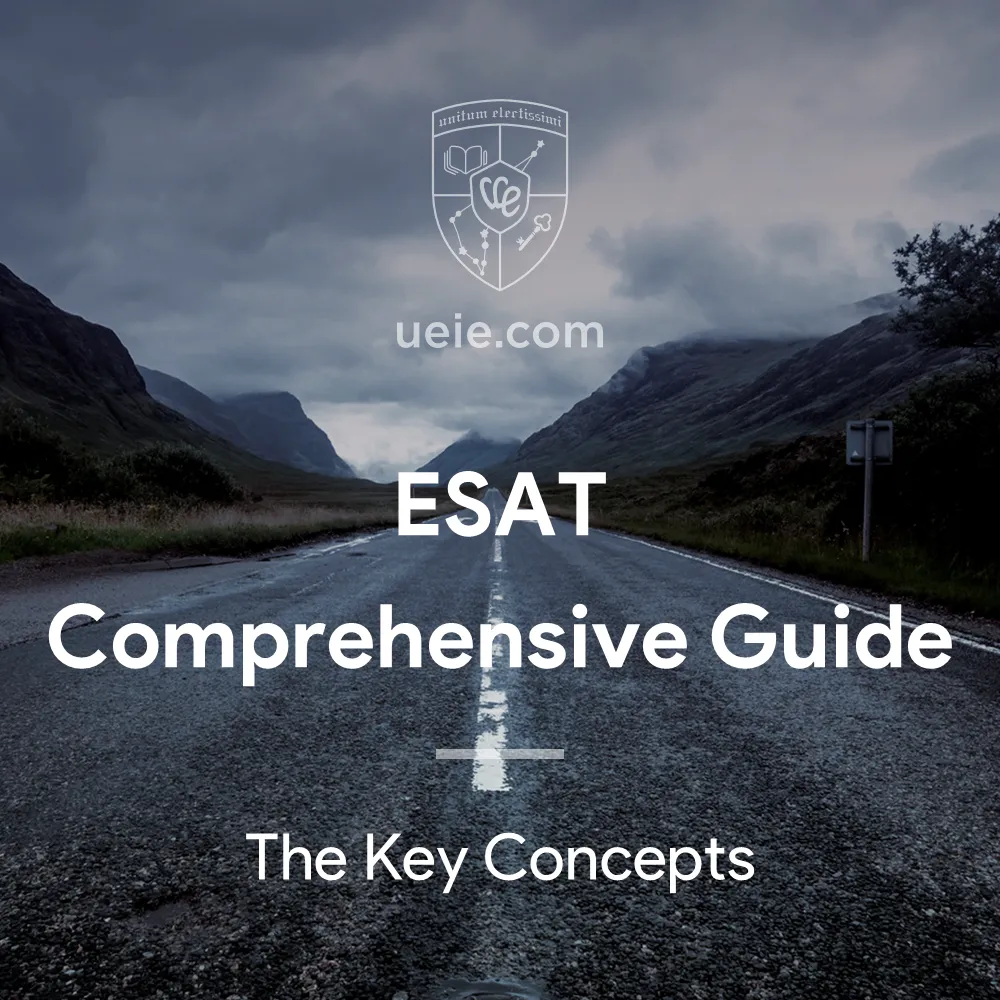
ESAT Explained: Navigating the Modular Test for Science & Engineering

The Engineering and Science Admissions Test (ESAT) is a pivotal assessment utilized by prominent universities, including the University of Cambridge, Imperial College London, and University College London (UCL). Its purpose is to evaluate the academic potential of undergraduate candidates applying for courses in engineering, natural sciences, and related disciplines. This document offers a systematic and comprehensive overview of the ESAT test, designed to help you thoroughly understand the latest requirements and essential information regarding the test. It covers critical aspects such as the test’s format, content, scoring system, and specific prerequisites. Once you have familiarised yourself with the details of the ESAT, it is highly recommended that you consult the ESAT Preparation Guide and ESAT Registration Guide, which I have authored, for more detailed instructions for registration and guidance on preparation strategies.
I. What is the ESAT Test?
ESAT stands for the Engineering and Science Admissions Test. It is a computer-based admissions test managed and operated by UAT-UK (University Admissions Tests – UK), a non-profit organisation jointly established by the University of Cambridge and Imperial College London.
The ESAT test aims to thoroughly assess the academic potential of students applying for specific undergraduate courses at universities like Cambridge and Imperial College, focusing on their ability to apply scientific and mathematical knowledge to solve complex problems.
The ESAT test is administered globally by Pearson VUE, a leading provider of assessment services.
II. ESAT Updates (2025/26 Admissions Cycle)
Since its initial implementation in 2024, the core format of ESAT—as a relatively new admissions assessment involving online computer-based testing, modular multiple-choice questions, and no calculators—remains consistent for the admissions cycle for entry in 2026.
The main updates pertain to operational aspects, such as specific test dates, registration windows, and associated fees for the 2025-2026 application cycle.
Regarding the ESAT itself, there is currently no information indicating significant changes to the test content, structure, or scoring criteria. Candidates are advised to regularly check the official UAT-UK website and the admissions pages of their target universities for the most authoritative and up-to-date official information.
III. Who Needs to Take the ESAT Test?
1. Universities and Courses Requiring ESAT
For students planning to apply for entry in 2026, the following universities require ESAT as part of the admissions assessment for specific undergraduate courses, departments, or faculties:
University Course / Department / Faculty University of Cambridge Chemical Engineering and Biotechnology Engineering Natural Sciences Veterinary Medicine
Imperial College London Department of Aeronautics Department of Chemical Engineering Department of Civil and Environmental Engineering Dyson School of Design Engineering Department of Electrical and Electronic Engineering Department of Mechanical Engineering Department of Physics University College London (UCL) Electronic and Electrical Engineering
Important Reminder: University admission requirements may be subject to minor adjustments each year. All applicants must visit the official admissions websites for their target institutions and specific courses to obtain the latest and most authoritative information regarding entrance test requirements for the 2026 entry cycle (including whether the ESAT test is needed and the specific combination of subject modules required). Do not rely solely on third-party information.
2. ESAT Module Selection
ESAT consists of five modules (Mathematics 1, Mathematics 2, Physics, Chemistry, Biology). The requirements vary by university and course, typically requiring candidates to select three modules:
- Compulsory Module: Mathematics 1 is usually a compulsory module required by all courses.
- Optional Modules: Two additional modules are selected based on the specific course requirements.
3. Examples of ESAT Module Choices for Different Courses
University of Cambridge:
- Engineering: Requires Mathematics 1 + Mathematics 2 + Physics.
- Other specified courses: Mathematics 1 is compulsory; the other two modules can be chosen freely from the remaining options.
Imperial College London:
- Chemical Engineering: Requires Mathematics 1 + Mathematics 2 + Chemistry.
- Physics / Aeronautics / Civil / Electrical / Mechanical Engineering: Most require Mathematics 1 + Mathematics 2 + Physics.
- Design Engineering: Requires Mathematics 1 + Mathematics 2; the third module can be chosen freely.
- Other specified courses: Mathematics 1 is compulsory; the other two modules can be chosen freely.
UCL:
- Electronic and Electrical Engineering: Mathematics 1 is compulsory; the other two modules can be chosen freely.
4. Candidate Responsibility
When registering for the ESAT test (via the Pearson VUE platform), candidates are responsible for selecting and registering for the correct combination of subject modules based on the requirements of all the institutions and courses they are applying to. Selecting incorrect modules may invalidate an application.
IV. Key Dates for the ESAT Test
Below is a summary of the key dates for the two test sittings in Autumn 2025 and early 2026. (Please note that registration periods are indicative; specific start and end dates require close attention to official updates).
1. Autumn 2025 (Sitting 1) Schedule
Key Stage Date Registration Period 31 July 2025 to 29 September 2025 Test Dates 9-10 October 2025 Results Released 14 November 2025* Key Restrictions:
- Candidates applying to relevant courses at the University of Cambridge must take the test in this sitting.
- Candidates applying to the University of Cambridge from mainland China, Hong Kong, and Macao are not permitted to take the test on 9 October and must sit the test on 10 October.
2. Early 2026 (Sitting 2) Schedule
Key Stage Date Registration Period 27 October to 19 December 2025 Test Dates 6-7 January 2026 Results Released Approximately 6 weeks after the test* Key Restriction:
- This sitting is not available for candidates applying to the University of Cambridge.
* UAT-UK will notify candidates by email when their results are available to view in their UAT-UK account. Candidates will also receive a document explaining their results to provide further information on how to interpret their scores.
V. ESAT Format and Structure
The specific format and structural elements of the ESAT test are summarised in the table below:
Feature Details Test Mode Online, computer-based test Test Location Authorised Pearson VUE test centres worldwide Subject Modules 5 independent modules: - Mathematics 1
- Mathematics 2
- Physics
- Chemistry
- Biology
Module Structure Each module consists of 27 multiple-choice questions Module Duration 40 minutes per module Timing Each module is timed independently and taken sequentially. Unused time from one module does not carry over to the next. Module Selection Candidates must select the module combination required by their chosen universities and courses (typically 3 modules; see Section III). Calculators Not permitted Dictionaries Not permitted Ancillary Tools An erasable booklet and pen will be provided at the test centre for rough work. Key Points Interpreted:
- Pace Requirement: Completing 27 science or mathematics multiple-choice questions in 40 minutes equates to approximately 1.5 minutes per question. This demands a high level of subject knowledge proficiency, problem-solving speed, and rapid judgment.
- Independent Module Timing: Requires candidates to possess good time management skills to allocate time effectively within each module.
- No-Calculator Environment: Places significant demands on candidates’ mental arithmetic, written calculation, estimation skills, and the memorisation and fluent application of formulae and constants.
VI. ESAT Scoring Mechanism and Results Interpretation
Understanding how ESAT is scored and what the scores mean helps candidates to evaluate their performance more scientifically and comprehend its role in the application process.
1. Scoring Method
- Basic Rule: 1 mark is awarded for each correct answer.
- No Penalty: No marks are deducted for incorrect or unanswered questions; they simply score 0.
- Raw Score: Each module contains 27 multiple-choice questions, resulting in a maximum raw score of 27 per module.
2. Results Presentation
- Score Conversion: To ensure comparability across different test versions and sittings, the raw score for each module (0-27) is converted to a standardised score on a scale of 1.0 to 9.0, typically reported to one decimal place.
- Independent Reporting: The candidate’s final results report will list the standardised score achieved for each subject module taken. No total or average score is calculated.
- Accessing Results: Test results are usually released approximately 6 weeks after the test date. Candidates receive an email notification and can access their results via their UAT-UK account. Exam boards typically send results automatically to UCAS-listed universities requiring the score.
3. Results Interpretation and Use
- No Fixed ‘Cut-off’ Score: Neither UAT-UK nor the admitting universities set a uniform ‘interview cut-off’ or ‘offer threshold’ score.
- Differentiation Tool: The test is designed to effectively differentiate amongst academically strong applicants, providing an additional dimension of comparison, particularly within a pool of high-achieving candidates.
- Holistic Assessment Component: The ESAT score is an important reference point in the university admissions assessment process but is by no means the sole criterion. Admissions tutors consider it alongside the applicant’s academic background (e.g., A Level/IB predicted or final grades), personal statement, references, and potentially interview performance.
4. Score Competitiveness Analysis
Based on the official UAT-UK interpretation of ESAT results for 2024/25, combined with personal experience from tutoring students, here is an interpretation of representative scores:
- 4.5 represents the average standard: This suggests that most students score around 4.5. Observations indicate that many students achieving A* grades in relevant A Level subjects can reach this level without specific systematic preparation. Universities generally consider a 4.5 score roughly equivalent to A* grades in relevant A Level subjects.
- Around 7.0 places candidates in the top 10%: Experience from previous application cycles suggests that students achieving an average score of 7.0 or higher across their three modules generally receive interview invitations from Cambridge and have a high success rate for offers from Imperial College.
- Only about 5% of candidates score 8.0 or above: Unquestionably, candidates scoring in the 8.0−9.0 range are extremely competitive. While final admission to Cambridge also depends on a holistic review including the interview and other materials, the likelihood of receiving a direct offer from Imperial College is very high.
VII. ESAT Syllabus Overview and Difficulty Analysis
Accurately understanding the scope and difficulty characteristics of the ESAT is fundamental to formulating an effective preparation plan.
1. Syllabus Scope
- Knowledge Base: The ESAT syllabus is broad, primarily based on the core knowledge of UK A Level (or equivalent qualification) Mathematics, Physics, Chemistry, and Biology. It assumes candidates possess a solid foundation in the corresponding subjects at GCSE level (or equivalent).
- No Advanced Content: The syllabus does not include A Level Further Mathematics content or topics beyond the scope of standard A Level Physics, Chemistry, or Biology.
2. Core Content Overview by Module
The following outlines the main knowledge areas covered by each module (for a detailed list, always refer to the official syllabus):
Mathematics 1:
- Fundamental arithmetic and number concepts, units, ratios and proportions, algebra (including equations, inequalities, polynomials), coordinate geometry and plane geometry, basic statistics and probability. (Roughly corresponds to GCSE and some A Level Mathematics content).
Physics:
- Electricity (circuits, fields), basic magnetism, kinematics, Newton’s laws, energy and momentum, circular motion, moments, basic thermal physics, properties of matter, waves (including basic optics), atomic physics and radioactivity. (Roughly corresponds to core AS and some A2 Physics content).
Chemistry:
- Atomic structure and periodicity, stoichiometry and equations, redox, bonding and structure, states of matter and particle theory, main group chemistry, separation techniques, acids, bases and salts, reaction kinetics, introductory chemical thermodynamics, introductory electrochemistry, core organic chemistry, metals and their reactions, air and water, introductory chemical analysis. (Roughly corresponds to core AS and some A2 Chemistry content).
Biology:
- Cell structure and function, biological molecules, enzymes, cell transport, cell division and genetics, DNA and gene technology, variation and evolution, animal physiology (respiration, circulation, digestion, nerves, endocrine system, etc.), plant physiology, ecosystems. (Roughly corresponds to core AS and some A2 Biology content).
Mathematics 2:
- Advanced algebra and functions (including polynomials, modulus function, mappings), sequences and series, coordinate geometry (including parametric equations, introduction to conic sections), trigonometry (including sum/difference formulae, double angle formulae, trigonometric equations/inequalities), exponential and logarithmic functions, calculus (differentiation, integration for area/volume), using calculus to analyse graphs. (Roughly corresponds to AS Mathematics and some A2 Pure Mathematics content).
3. Difficulty Characteristics Analysis
- Challenging by Design: Officials explicitly state that ESAT is designed to effectively differentiate top-tier applicants, and the questions are intended to be challenging.
- Breadth and Depth of Knowledge: The test covers a wide range, requiring a deep understanding and fluent mastery of core A Level knowledge, not just superficial memorisation. The multiple-choice format particularly tests the precision of conceptual understanding.
- Extreme Time Pressure: The average time of 1.5 minutes per question presents a significant challenge to knowledge retrieval speed, problem-solving efficiency, and rapid decision-making abilities.
- No-Calculator Environment: Places strict demands on the accuracy and speed of mathematical operations (mental arithmetic, written calculation, estimation), unit conversions, and the recall and application of formulae.
- Integrated Application Skills: Questions may integrate multiple concepts, requiring strong analytical and application skills from candidates.
- Overall Difficulty: Considered no less demanding than the NSAA/ENGAA tests it replaces, with high requirements for logical reasoning, mathematical application, and scientific literacy.
VIII. How to Register for the ESAT Test?
1. Main Process Overview
Pearson VUE primarily handles ESAT test registration. As UAT-UK’s official partner, their online platform manages bookings.
- Create a UAT-UK Account: After the registration period begins (expected from early June 2025), you will need to visit the Pearson VUE official website and follow the instructions to create a UAT-UK personal account. Please ensure that you use personal information consistent with your UCAS application and identification documents for registration.
- Book the Test and Select Modules: Once your account is successfully created and you have logged in, during the exam booking window (expected from early August 2025), you can book the ESAT test within the Pearson VUE system. The crucial step is to select the correct combination of subject modules based on the university program requirements as described in Part Three and verified by you. Simultaneously, you need to choose a suitable exam date, time, and test center.
- Pay the Test Fee: Follow the system prompts to complete the online payment of the exam fee.
- Confirm Registration Information: Before submission, carefully review all registration information, including personal details, exam subjects, time, and location. You will usually receive a confirmation email after successful registration.
2. Obtain Detailed Registration Guidance
For specific account registration steps, detailed information required, methods for querying and selecting test centers, payment methods, the process and deadlines for applying for special exam arrangements (if needed), and important notes during the registration process, you can log in to the Pearson VUE official website or refer to our specially compiled ESAT Registration Guide for complete and detailed step-by-step operational guidance.

How to Register for ESAT
Our comprehensive 4-step guide is designed to make it easy for you to register for ESAT. Follow our instructions to complete your application.IX. Core Preparation Strategies and Resource Recommendations
1. Core Preparation Strategies
To successfully meet the challenge of ESAT, preparation needs to focus on the following core areas:
- Knowledge Level: Deeply understand and master the A Level (or equivalent) mathematics and science knowledge required by the official syllabus.
- Skill Level: For the online multiple-choice format, focus on training for extremely high problem-solving speed and accuracy, proficient multiple-choice test-taking skills, and complete adaptation to a calculator-free calculation environment.
- Practical Level: Through extensive practice and simulation, transform knowledge and skills into stable performance under time pressure, and familiarize yourself with the operation of the online examination platform.
The above are only the core directions for ESAT preparation. For detailed strategies and steps on how to systematically plan your preparation, implement learning in stages, use specific training methods (such as error analysis, time management skills), and improve specific abilities, please be sure to read my specially written: ESAT Preparation Guide

Conquer the ESAT: Multi-Subject Strategies for Online Test Success
Conquer the ESAT test required for top Science & Engineering courses. This guide offers strategies for multi-subject preparation (Maths, Physics, Chem, Bio), mastering the online format, enhancing speed & accuracy without a calculator, and effective resource use.2. Official Core Resources
You can obtain the most authoritative information through the core channels on the UAT-UK official website, including:
- The latest version of the ESAT test syllabus
- Official sample questions and practice materials
- Exam guidance and frequently asked questions
- Past papers for ENGAA and NSAA (2016-2023)
3. UEIE ESAT Courses and Materials
To help candidates prepare systematically and efficiently, I, Teacher Xie Tao, led an experienced teaching team. Together, we developed the ‘UEIE ESAT Self-Study Package’, which includes:
- ESAT Video Lecture Series: In-depth explanations of core test points and problem-solving methods (covering Mathematics 1, Mathematics 2, and Physics modules).
- ESAT Practice Question Bank: Provides a vast number of online practice questions, graded by topic and difficulty, for intensive training (covering Mathematics 1, Mathematics 2, and Physics modules).
- ESAT Full-Length Mock Exams: Multiple sets of high-quality original online mock test papers, covering all five subject modules.
We annually revise and update these materials. This ensures they match the latest exam trends and requirements.

ESAT & PAT On-Demand Prep Suite
The ESAT & PAT On-Demand Prep Suite, developed by Xie Tao, is your all-in-one solution for exam success, which includes video lectures covering Maths, Physics, over 1600 practice questions with detailed solutions, and full-length mock exams for ESAT Maths 1, Maths 2, Physics, and the Oxford PAT. Prepare thoroughly and maximise your score.US$612 – US$2 427Price range: US$612 through US$2 427
In addition, we also cooperate with several international schools to offer ESAT preparation classes. Interested students and parents can learn more about related courses and materials through the following link.

ESAT & PAT Preparation Programme
All-in-one exclusive resources. This programme features a 3000+ question bank, 9 unseen mock exams for each test, and 3 ESAT predictive papers to help you systematically master both new exams. Click to view the bundle.US$3 831 – US$14 265Price range: US$3 831 through US$14 265
4. Other Supplementary Resources
- High-Quality Online Question Banks: Platforms like Isaac Physics offer a large number of practice questions related to A Level Physics and Mathematics that help develop thinking skills.
- Relevant Subject Textbooks and Workbooks: Quality textbooks and workbooks for A Level subjects help consolidate foundational knowledge.
- Past Papers from Related Exams: Some questions from the discontinued NSAA/ENGAA exams, after careful comparison with the syllabus and question types, can be selectively used to practice specific knowledge points or ways of thinking.
5. Resource Usage Suggestions
- Prioritize Official Materials: Focus on the UAT-UK official syllabus and sample/past papers.
- Targeted Approach: Selectively use supplementary resources based on your preparation stage and areas of weakness.
- Choose Quality over Quantity: Resources should be high-quality rather than numerous to avoid information overload.
- Active Learning: Actively think, deeply review, and summarize when using any resource.
X. Next Steps Recommended
After reviewing this ESAT Comprehensive Guide, you should now possess a clear and thorough understanding of this significant admissions assessment. To transform this knowledge into effective application preparation, I recommend the following actions:
1. Verify Official Requirements
Promptly visit the official admissions websites for all your target universities and programs. Reconfirm their latest and most accurate entrance requirements for 2026 matriculation, paying particular attention to whether ESAT is mandatory and the specific combination of subject modules required. This information is foundational to all subsequent planning.
2. Plan Your ESAT Test Registration
Carefully read the ESAT Registration Guide to gain a complete understanding of the procedural details, including account creation, information submission, test center selection, fee payment, and applications for special accommodations.
3. Develop a Preparation Strategy
Thoroughly study the ESAT Preparation Guide. Tailor a detailed, actionable, and phased study plan to your individual circumstances, and begin your preparations as early as possible.
4. Select High-Quality Study Materials
In line with your preparation strategy, selectively utilize high-quality supplementary resources. For example, leverage the preparatory courses and materials available on the UEIE ESAT Preparation Hub for systematic study and targeted practice.

ESAT Prep Hub
Master the ESAT with UEIE’s Prep Hub! We offer everything you need to succeed: in-depth video lecture series, extensive practice question bank, realistic full-length mock exams, expert guides, and insightful data analysis.Finally, I wish you the very best in your ESAT preparation and hope you achieve your desired outcomes in your university applications!
-

How to Register for ESAT
For students aspiring to read engineering or natural sciences at the University of Cambridge or Imperial College London, the Engineering and Science Admissions Test (ESAT) result is a key determinant of their ultimate success in gaining admission. However, many students and their parents are unacquainted with the particulars of ESAT registration, such as the procedures for enrolment, the pertinent timelines, and the appropriate examination session for which to register. This article will, therefore, provide a detailed exposition and guidance on the various processes and facets of ESAT registration, aiming to elucidate these matters and resolve any uncertainties.
I. ESAT Organisation and Administration
Since 2024, the ESAT has been centrally managed by UAT-UK (University Admissions Tests – UK), a not-for-profit organisation. UAT-UK focuses on university entrance examinations in the United Kingdom and currently oversees two computer-based testing programmes: ESAT and TMUA. Pearson VUE delivers these tests. It is the certification and licensure arm of Pearson, an internationally recognized learning company. With a vast network of over 5,500 test centres across more than 180 countries and territories, Pearson VUE provides professional assessment services to academic and admissions bodies globally.
II. Key Dates for the 2025 ESAT Examinations
The ESAT has two examination sittings, scheduled for October 2025 and January 2026. The pertinent dates are outlined below:
1. October 2025 ESAT Examination
31 July 2025 ESAT Registration Opens 29 September 2025 ESAT Registration Closes 9 & 10 October 2025 ESAT Test Dates 14 November 2025 ESAT Results Released 2. January 2026 ESAT Examination
27 October 2025 ESAT Registration Opens 19 December 2025 ESAT Registration Closes 6 & 7 January 2026 ESAT Test Dates To Be Confirmed (anticipated within six weeks of the test) ESAT Results Released Important Notes Regarding Test Window Selection:
Applicants to the University of Cambridge must register for and sit the October examination. The January examination is not available to Cambridge applicants.
Specific Date Restriction for Certain Localities:
The University of Cambridge does not permit candidates from mainland China, Hong Kong, and Macau to sit the ESAT examination on 9 October 2025. Therefore, applicants from these localities targeting Cambridge must sit the ESAT examination on 10 October 2025.
III. ESAT Registration Procedure
1. Create a UAT-UK Account
1. Candidates must create a UAT-UK account on the official Pearson VUE website. (It is prudent to consult the official UAT-UK website for the latest registration guidance).
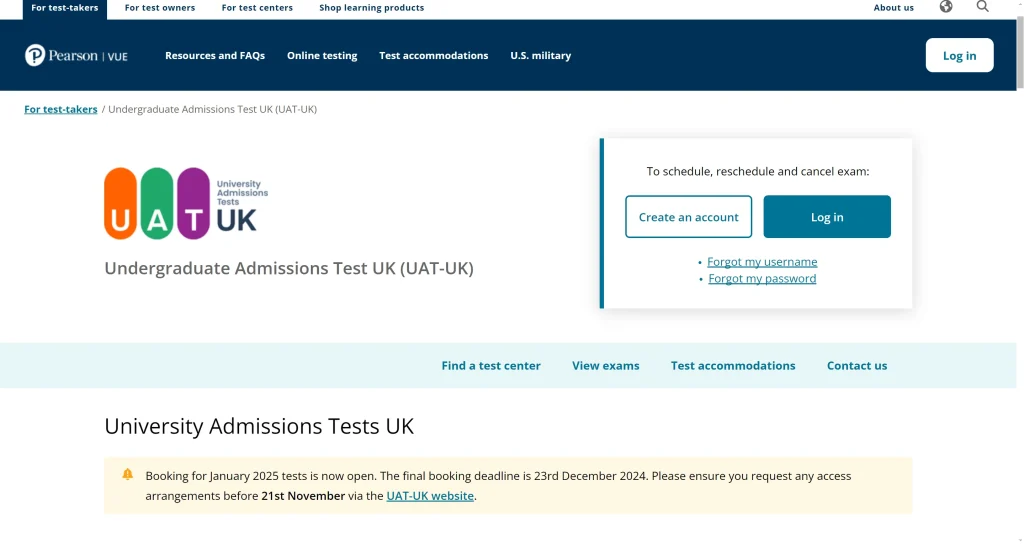
2. It is imperative that the name used for UAT-UK account registration precisely matches the name on the candidate’s identification document. Discrepancies may prevent the candidate from sitting the examination. Candidates should also ensure their name matches their UCAS application name.
3. After creating an account, Pearson VUE will email candidates. This email enables them to confirm details and account settings. Candidates should receive it within 24 hours. This email will also include a temporary password for the candidate’s account.
4. Upon receipt of the account confirmation email, candidates may log in using the temporary password, subsequently change their password, and locate their UAT-UK ID (format: UATUK######) in the top left-hand corner of the page navigation bar.
2. Examination Booking
1. Log in to your UAT-UK account on the official Pearson VUE website and select the option to book the ESAT examination.
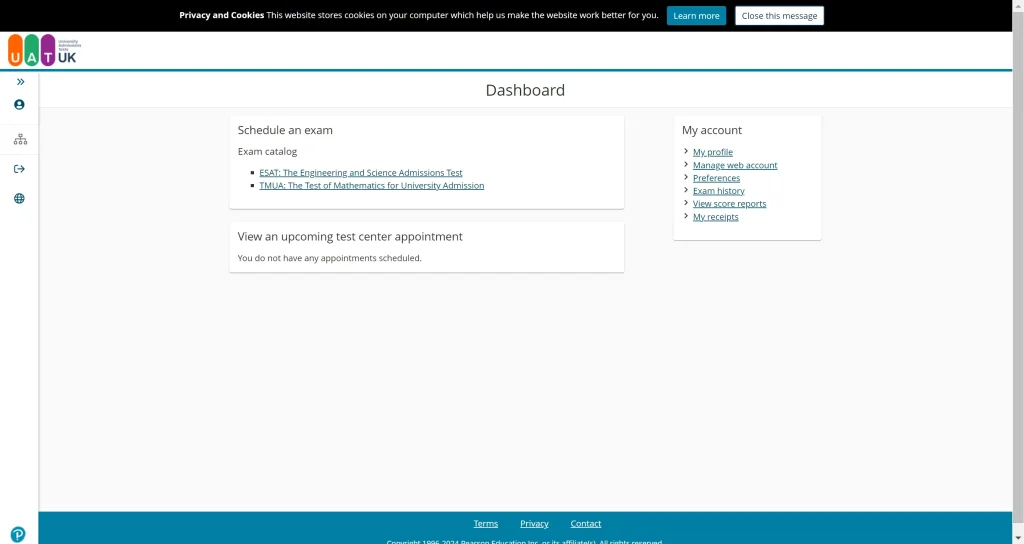
2. The ESAT examination comprises five sections. Typically, all candidates are required to sit the Mathematics 1 module. In addition to this, candidates will generally need to select two further modules from Mathematics 2, Physics, Chemistry, and Biology, in accordance with the requirements of their chosen university and specific programme of study. It is imperative that candidates meticulously consult the official admissions webpage of their prospective institution to confirm the precise subject combination stipulated for their intended course. Selecting an appropriate combination of subjects is likely to strengthen your university application.
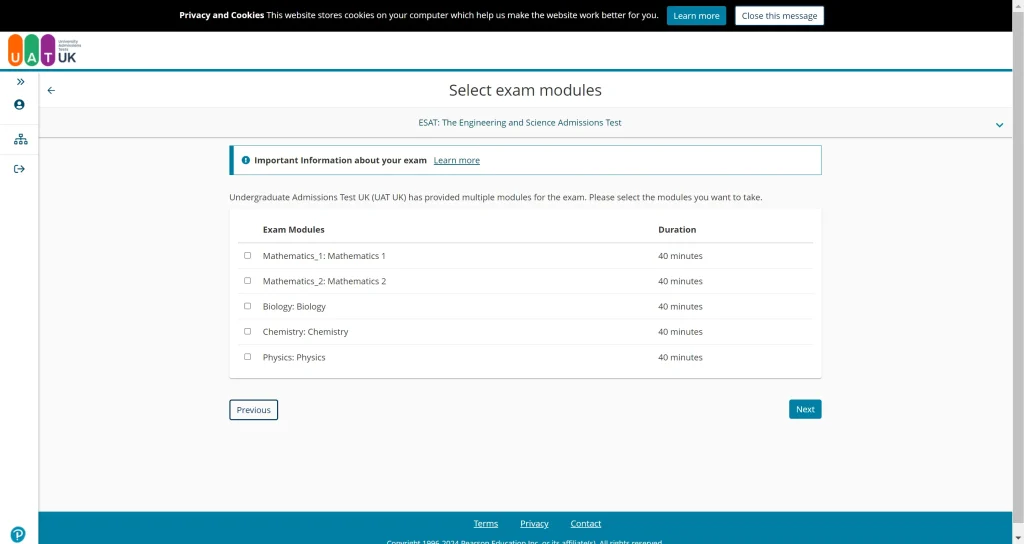
3. Provide personal information pertinent to the examination. The system denotes compulsory fields with an asterisk (*).
4. Candidates can locate their nearest test centre via the Pearson VUE website to complete their ESAT registration. Please note that sought-after test centres have limited places, especially as the registration deadline approaches. We strongly advise booking well in advance.
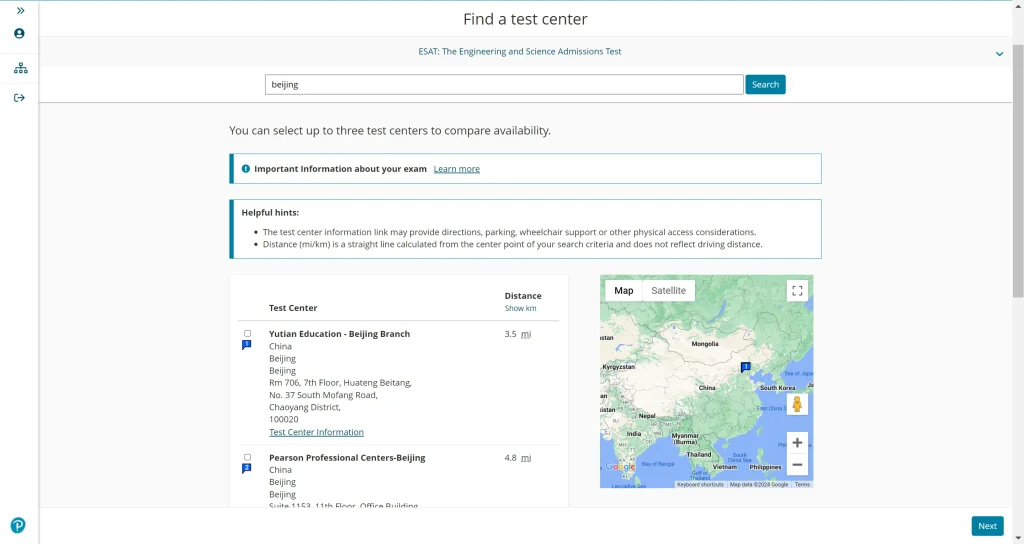
3. Post-Registration and Pre-Examination Steps
- Retain Confirmation Letter: It is strongly recommended that candidates save or print the examination confirmation letter issued by Pearson VUE once registration and payment are complete. This document usually serves as proof of entry for the examination.
- Familiarise Yourself with Test Centre Regulations: Candidates are advised to visit the Pearson VUE website or contact their test centre before the examination to apprise themselves of specific test centre rules and regulations.
- Official Contact Details: For any queries, candidates may contact the Pearson VUE candidate services helpline on 866 892 4788 (toll-free) or liaise with official customer service through the customer service centre on the Pearson VUE website.
4. Examination Fees
- For candidates sitting the ESAT examination outside the UK and the Republic of Ireland (including mainland China), the fee is generally £130.
- For candidates sitting the examination within the UK and the Republic of Ireland, the fee is £75.
IV. Access Arrangements
Candidates requiring access arrangements are advised to register for the examination at the earliest opportunity. Registering later may diminish the likelihood of securing arrangements at the preferred date and test centre. UAT-UK may take up to ten working days to process applications for access arrangements. Furthermore, the deadline for applying for access arrangements is typically in advance of the standard registration deadline. It is essential to check and submit such applications with ample time.
All applications for access arrangements must be substantiated by evidence from a medical practitioner or specialist teacher, clearly detailing the candidate’s disability, medical condition, or other relevant circumstances.
Types of access arrangements that necessitate application and approval include:
- 25% extra time
- Supervised rest breaks
- Separate invigilation (rooming)
- Use of a coloured reading overlay or bookmark
- A reader or scribe
- Other (please supply specific details of any aids or modifications required)
V. Cancelling ESAT Registration
- Candidates may cancel or amend their examination booking up to 48 hours prior to the scheduled test without penalty.
- Cancellations or amendments must be effected by logging into the Pearson VUE website account or by contacting customer services for assistance.
- Should a candidate fail to cancel or amend their booking in good time, or fail to attend the examination, the examination fee will be forfeit.
- It is important to appreciate that the ESAT examination is conducted over only two days. The feasibility of successfully rescheduling an examination date is dependent upon availability at the selected test centre.
- The precise cancellation and amendment policy will be as per the terms and conditions stipulated by Pearson VUE at the point of booking.
VI. Concluding Thoughts
As the 2025 ESAT examinations draw nearer, it remains of paramount importance for all students intending to apply for engineering and natural sciences programmes at the University of Cambridge and Imperial College London to acquaint themselves promptly with the latest examination updates and to familiarise themselves thoroughly with the complete ESAT registration procedure. Kindly make full use of this guide to prepare effectively for successful matriculation at your chosen institution.
Should you wish to explore further aspects of the ESAT examination, such as a comprehensive overview of test information, guidance on structuring your preparation timeline, and effective study strategies, you may also consult our other articles by clicking the link provided below.

ESAT Explained: Navigating the Modular Test for Science & Engineering
Applying for Science or Engineering at Cambridge, Imperial, UCL? Learn about the ESAT test (Engineering and Science Admissions Test). This guide explains the modular structure (choose 3 of 5), online format, syllabus basics, scoring, and crucial no-calculator rule.
Conquer the ESAT: Multi-Subject Strategies for Online Test Success
Conquer the ESAT test required for top Science & Engineering courses. This guide offers strategies for multi-subject preparation (Maths, Physics, Chem, Bio), mastering the online format, enhancing speed & accuracy without a calculator, and effective resource use.